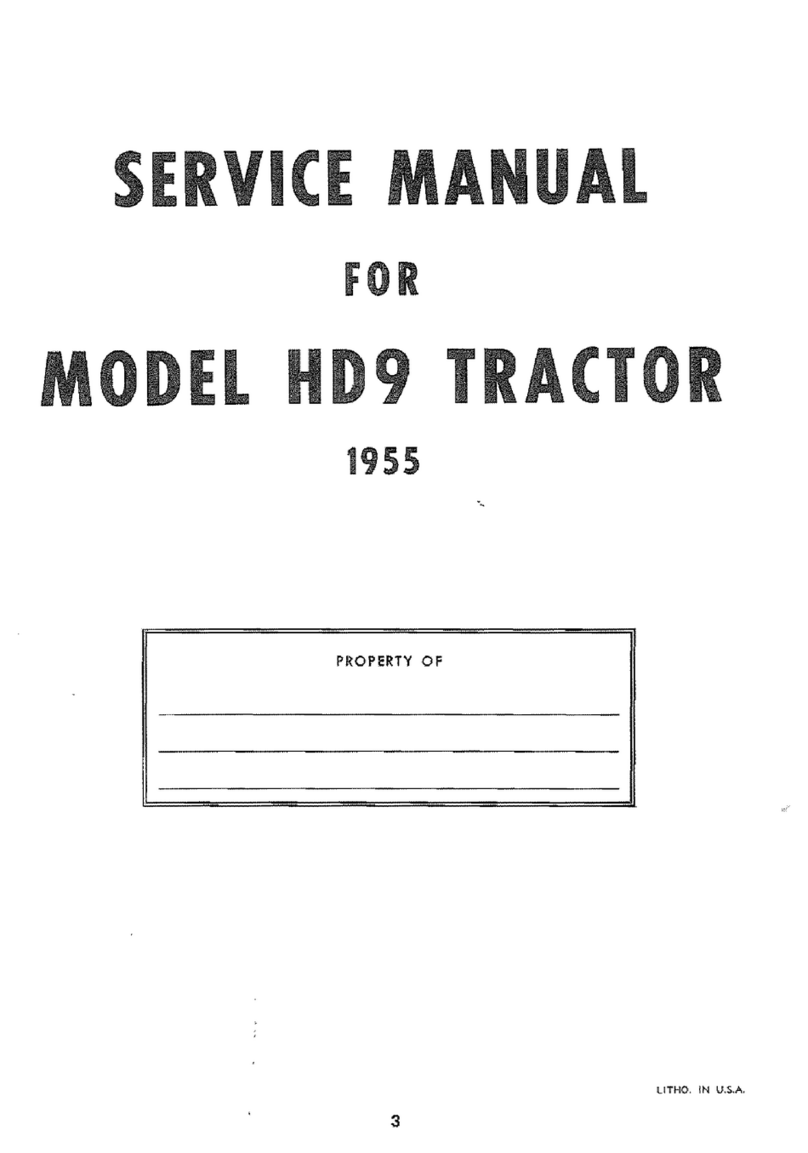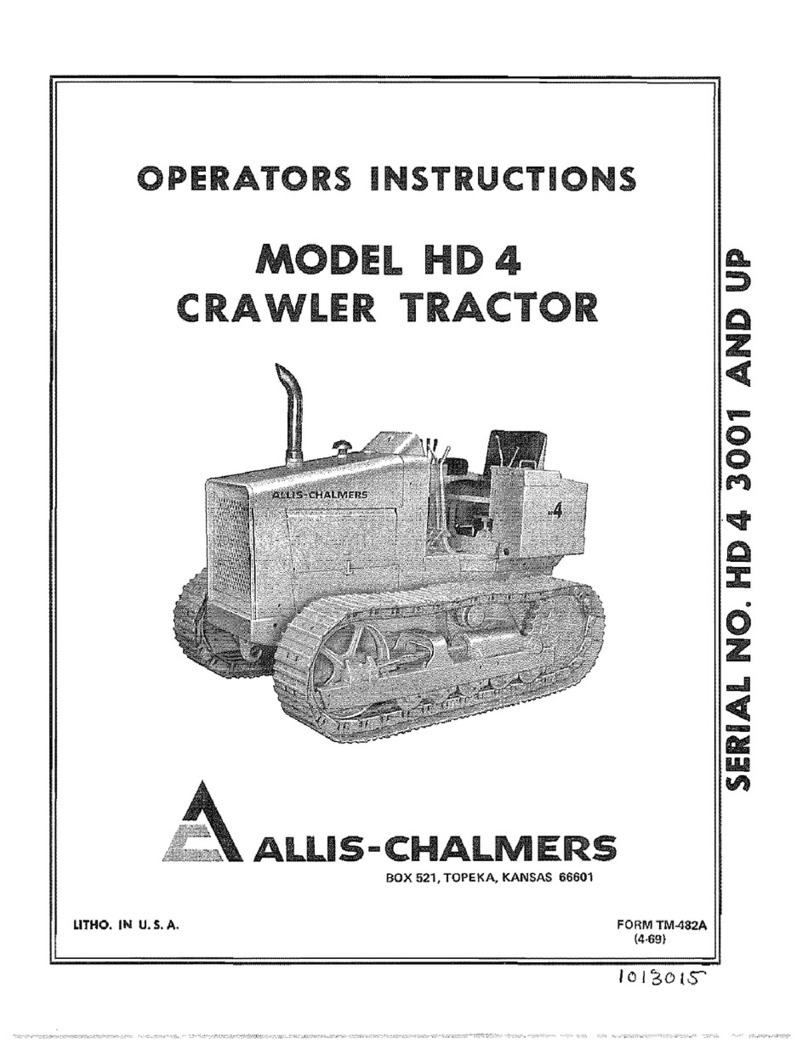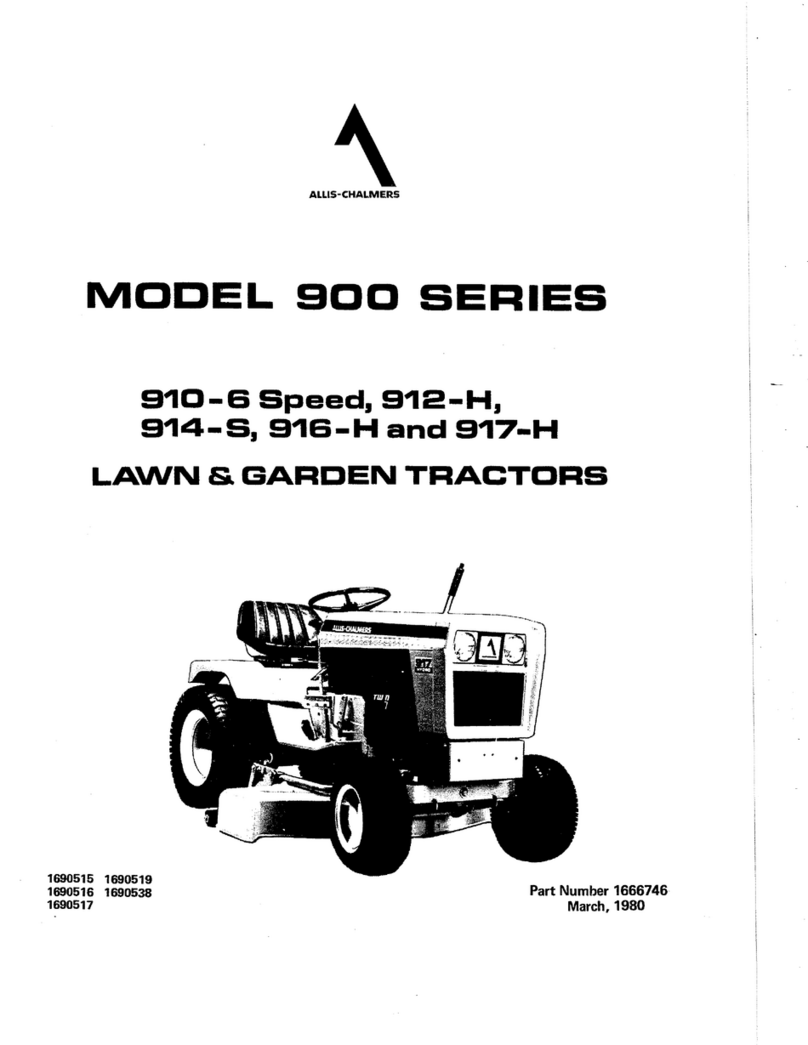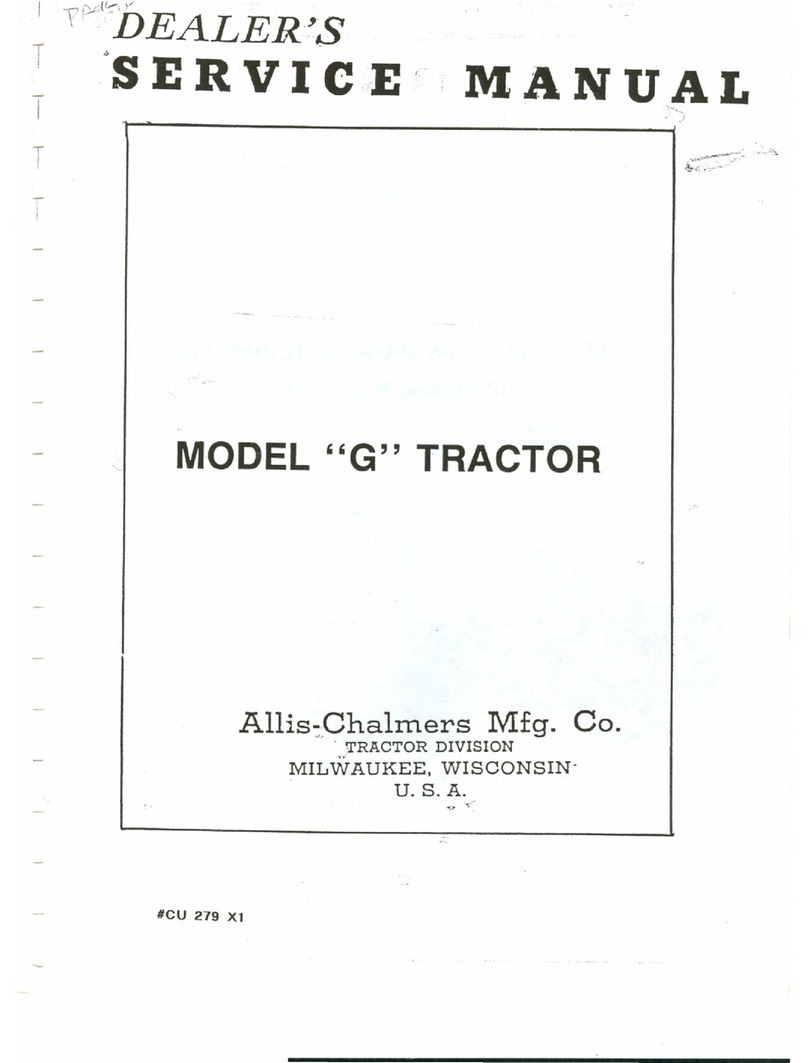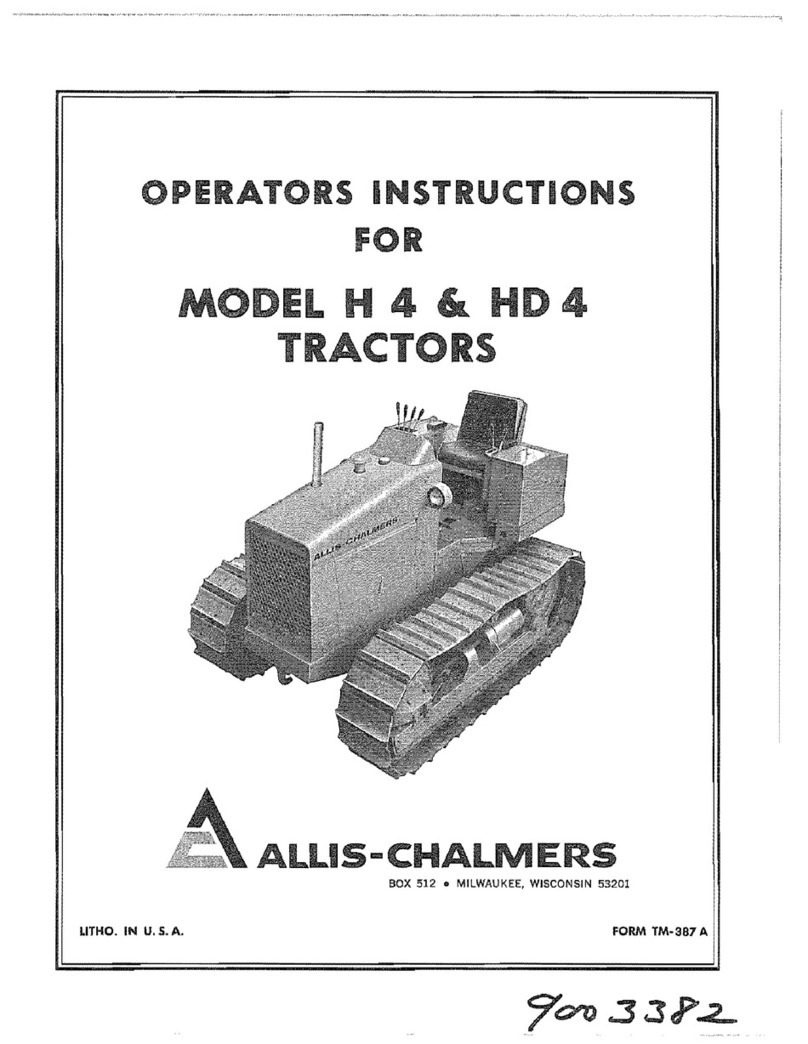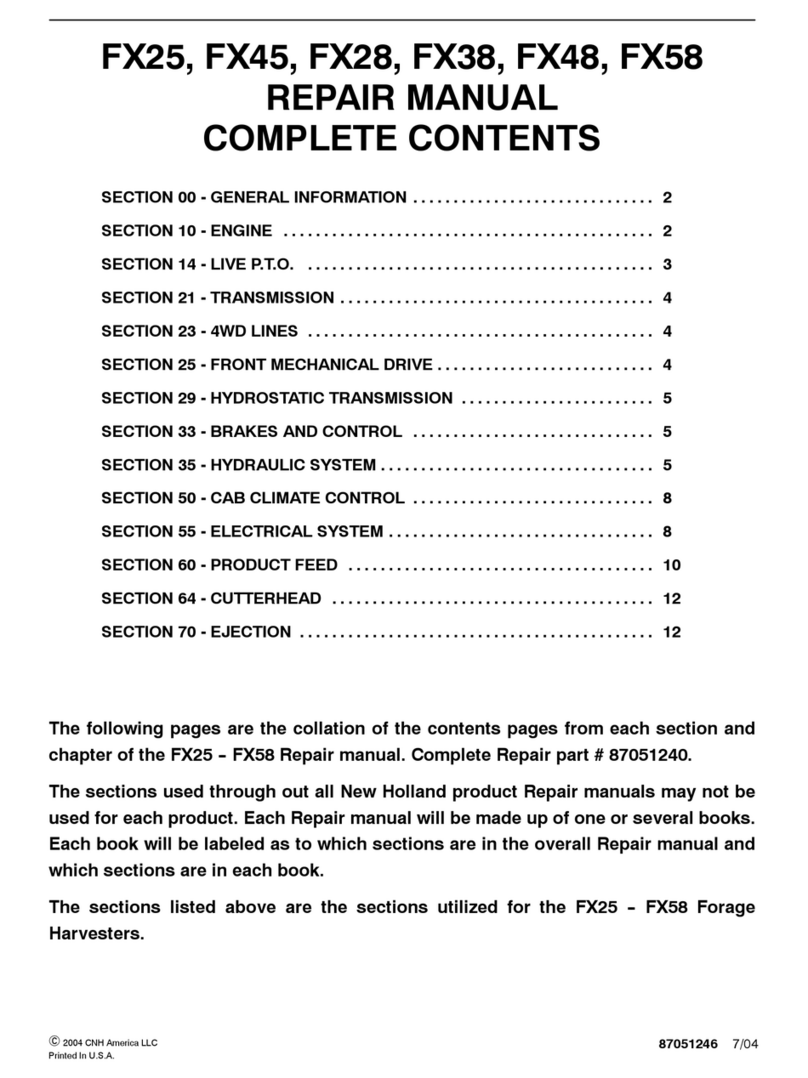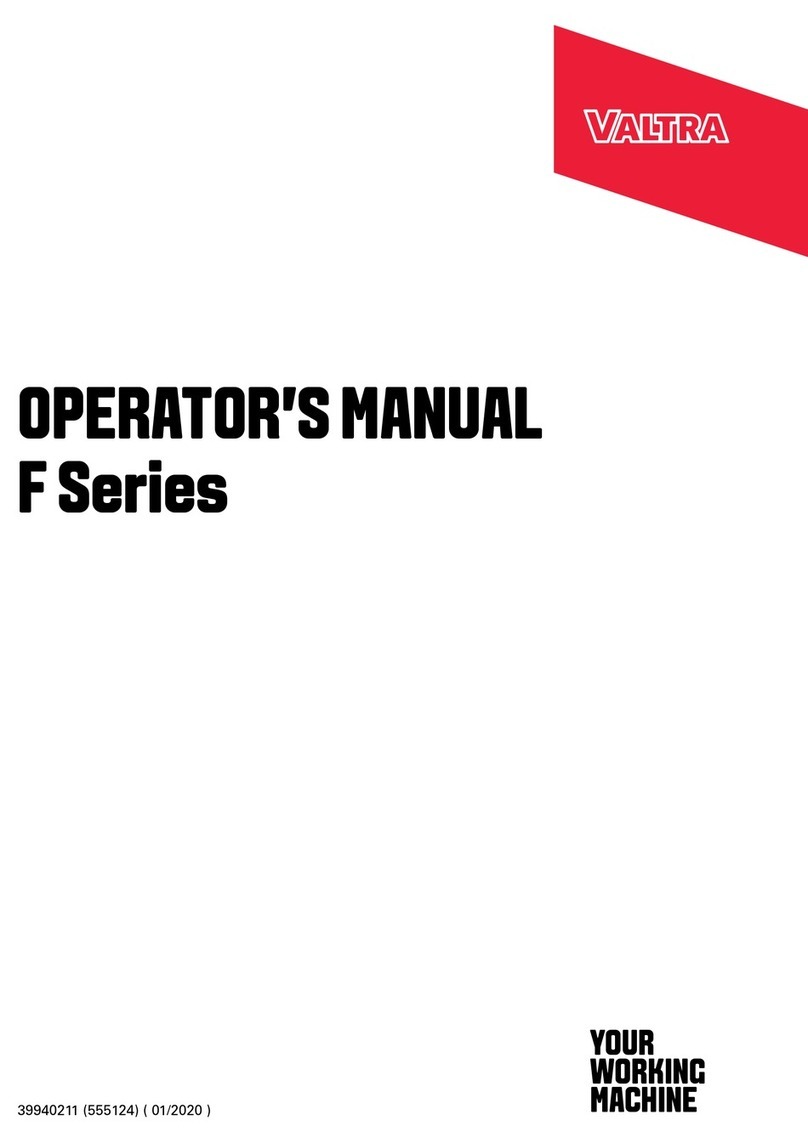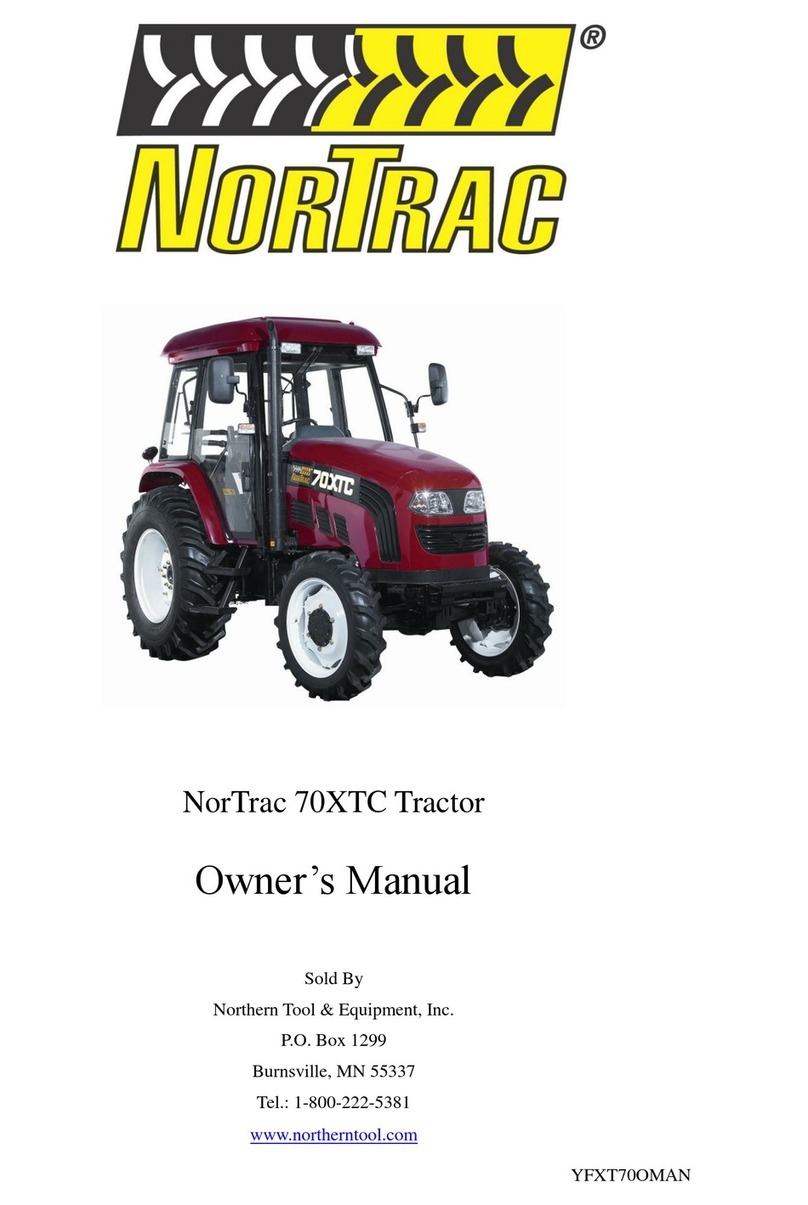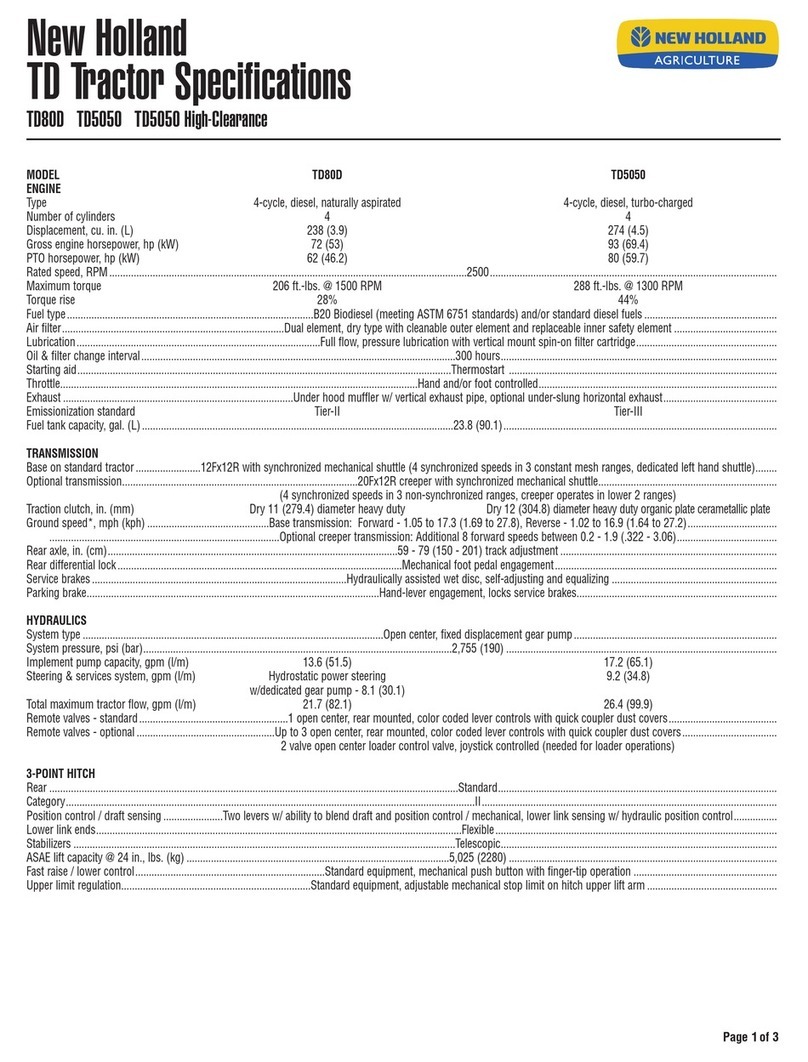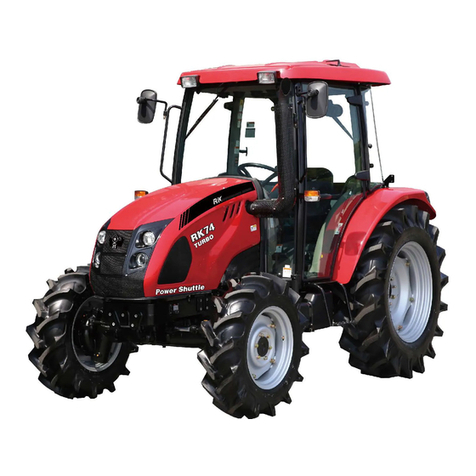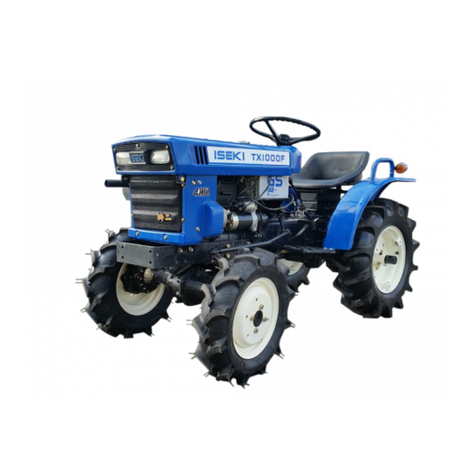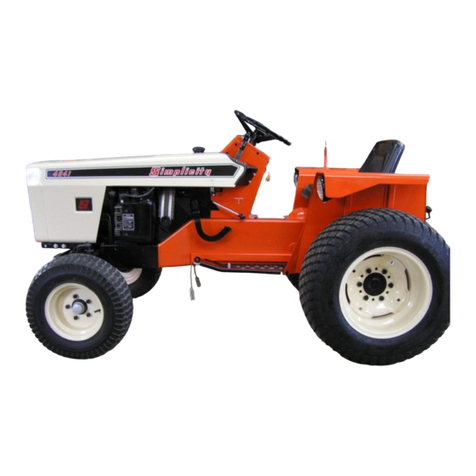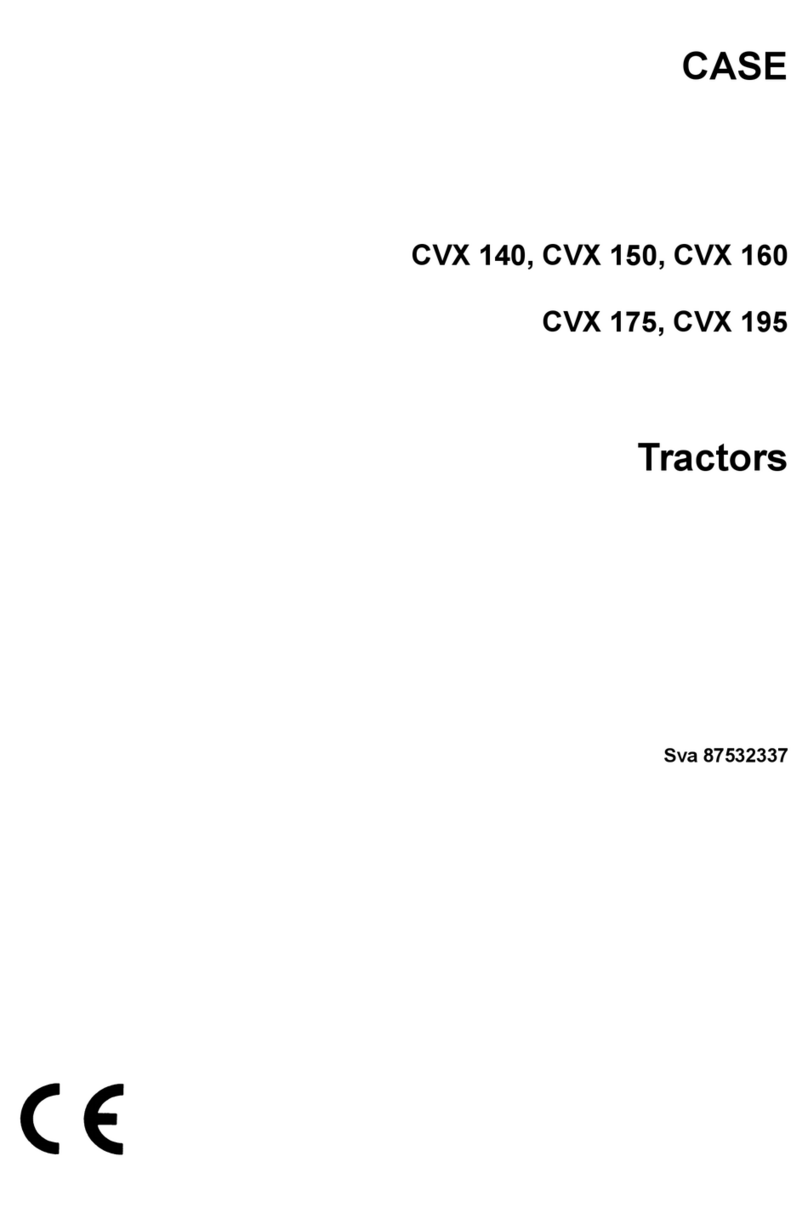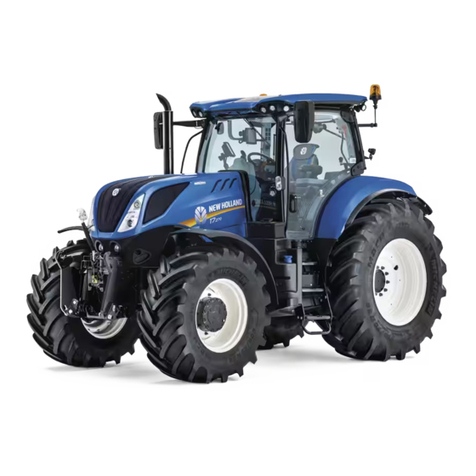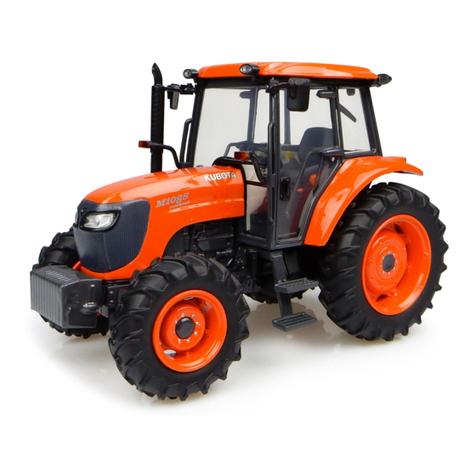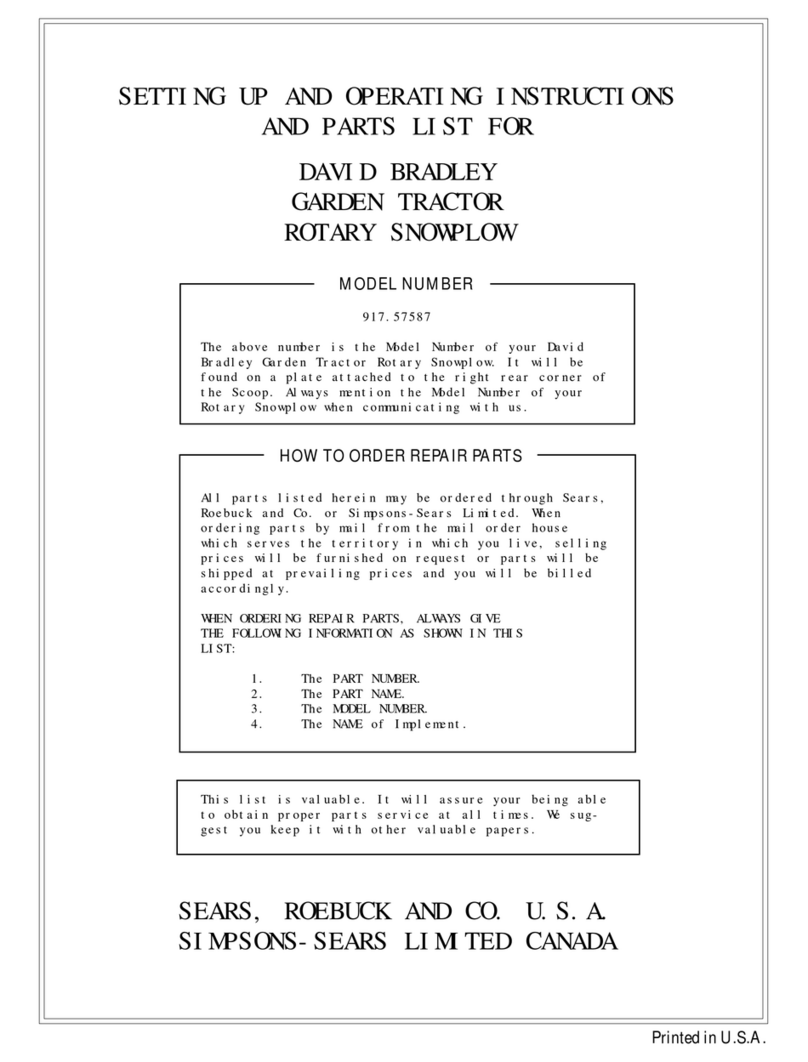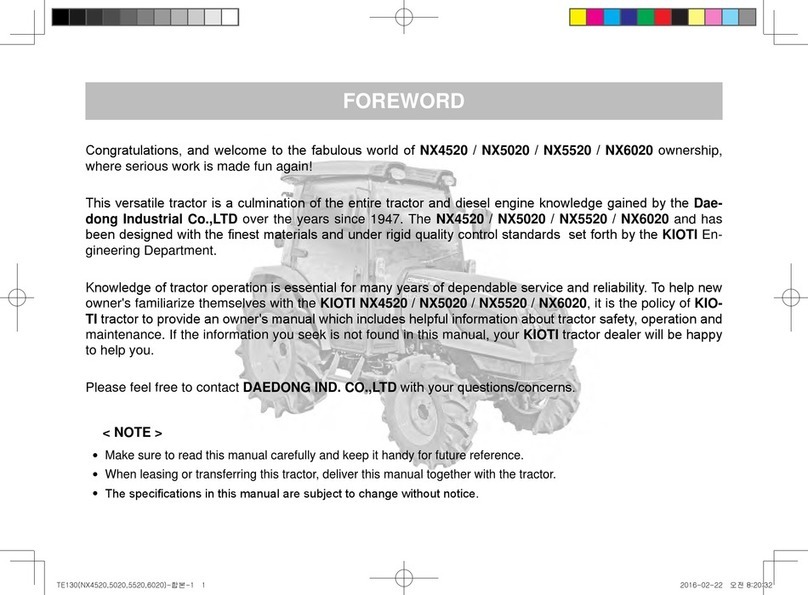Allis-Chalmers U Installation and user guide

FOREWORD
This book, covering the Service and maintenance of the Model "A",
"U" and "UC" tractors manufactured by "Allis-Chalmers" contains
material formerly incorporated in the loose leaf Farm Equipment Service
Manual, "Knowledge Means Power".
-:••• --A: :. ••.•••.••
A
It is material now seldom used but never the less very valuable when
needed. This is the last r.~~sion that will be made of these sections and
you should retain this book for your permanent file.
For information listed under "General Section" in indexes refer to
"General Sect ion" in loose leaf Farm Equipment Service Manual.
This book, like the material in loose leaf Farm Equipment Service
Manual "Knowledge Means Power", is printed for the exclusive use of
"Allis-Chalmers" Dealers in servici.ng and maintaining farm equip-
ment manufactured by "Allis-Chalmers".
PRICE $1.00
ALLlS-CHALMERS MFG. CO.
FARM EQUIPMENT DIVISION
MILWAUKEE, WISCONSIN
U.S.A.

MODELr~"TRACTORINDEX
SUBJECT SEC. PAGE PAGE PAGE PAGE PAGE
AIR CLEANER A1417
BELT PULLEY
Construction U239
*Construction U239
Lubrication A4
Specifications A2
7
*Specifications A27
BREATHER, ENGINE A420
BREA THER, TRANSMISSION A4
CAMSHAFT A111
CARBURETOR A1624 25
CARE
&
OPERATION A3456
CLEANING RADIATOR A8
CLUTCH
Adjustment A2
6
28
*Adjustment A2631
Lubrication A3
Removal A28
*Removal A31
Repair A28 29
*Repair A31 32
CONNECTING RODS A1513
COOLING SYSTEM A168
CRANKSHAFT A114
Oil Seals A
11
Main Bearings A11
CYLINDER HEAD A20 4Q
CYLINDER LINERS A1 11
DIAGNOSIS, HINTS FOR GENERAL, 32
OIFFERENTIAL U37
A24
DRAINING COOLING SYSTEM A68
ENGINE BLOCK A11
FAN BELT ADJUSTMENT A1
6
9
FRONT WHEELS
&
AXLES A
2-A
4627
FITTING PISTON PINS A214
FLYWHEEL A14
FUEL A·4
GEARSHIFT U332
*GEAR SHIFT A333
GOVERNOR
Adj ustment A1519
Construction A19
Removal A19
Type A1519
LINERS, CYLINDER A111
MAGNETO RV4 U18
MAGNETO FM GENERAL, 14
MAIN BEARINGS
Crankshaft A111
MANIFOLDS A 1 24
OIL FILTER A516
OIL LINES A16
OIL PRESSURE A315
OIL PUMP A15
OIL RELIEF VALVE A15
PISTONS A2513
PISTON PINS A214
*
Refers to Tractors No. 26526 and Up

MODEL
A
TRACTOR INDEX (Cont'd)
SUBJECT SEC. PAGE PAGE PAGE PAGE PAGE
PISTON RINGS A213
POWER TAKE-oFF U40
A
2-A
PUSH ,ROD ADJUSTMENT A 2 5 21
RADIATOR A1 6 8
REAR AXLE A
2-A
38
SPARK PLUGS A
1
6
SPECIFICA TIONS A 1 2
2-A
STARTING ENGINE A
3
STARTING TRACTOR A 3
STEERING GEAR A
2-A
421 22
TEMPERATURE, OPERATING
A
4
TIMING, IGNITION A 14
TIMING, MAGNETO U18
TIMING, MAGNETO GENERAL, 14
TIMING VALVES A211 12
TRANSMISSION
Bevel Pinion U 2 35
*Beve1 Pinion A
2-A
36
Cross Shaft
U
236
*Cross Shaft ;A
2-A
37
Sp1ine Shaft U2 34
*Spline Shaft A
2-A
35
Reverse Shaft U233
*Reverse Shaft A
2-A
34
Lubrication A4
VALVES
Adjustment A 25 21
Guides
A
221
Grinding A 5 21
Seat Inserts A 2 21
Lubrication A 20
Springs A 2 21
WATER PUMP A 3
939
*Refers to Tractors No. 26526 and Up
"

MODEL -A" SPECIFICATIONS
CRANKSHAFT
ENGINE
DATA
No. or cylinders 4
Bore 4-3/4" gasoline
S" low grade tuel
Stroke 6-1/2"
Gasol1ne motor:
Compression ratio 4.4 to 1
Compression pressure 86 Ibs.
Displacement - 460.7 cu. In.
Low Grade Fuel motor:
Compression ratio 4 to 1
~ompresslon pressure 76 Ibs.
Displacement Sll cu. In.
Firing order 1-3-4-2
R.P.M.
Low Idle 200-250
Full load 1000
High Idle 1100-1150
AIR CLEANER
Type - 011 bath
011 capac.1ty or cup - 2-1/2 pts.
Summer S.A.E. 20
Winter S.A.E-. 10
lhlst always splash rreely.
c.A.WHAFT
Drive - gear
Valve timing - marked gear
Journal dla.-2.l235"+ .OOOS"
or - .0005"
Bearings - 3 bronze bUShl~
Bearing dla.-2.128" •• OOOS
Bearing clearance .003S- to .OOSC"
End thrust - Spring controlled
CONNECTIOO ROD
Bearing - Spun type
Bearing length - 3.245" •• 001"
or - .001"
Journal length - 3.250- •• 004"
or - .001"
Bearing dla. - 2.753" + .OOOS"
or - .000S"
-Journal dla. - 2.750" .,..OOOf\"
or - .00>lS·
Dla. clearance .000" to .005"
Adjustment - Shims
COOLING SYSTDi
Capacity - 11-1/2 gallons
~ooled - Pump and Fan
Pump am ran dr1ve - two V Belts
Belt size -
Pitch length - S2"
Width - 21/32·
Depth - 7/16·
Angle - 40 degrees
Belt adjustment - eccentrl~ pump hag.
Pump bearing - Ball and Bushing
Pump lubrication ~ Grease tlttlng
Pump adjustment - Packing nut
Fan - 4 blade - 22· In dla.
Bearings - 3
Type - Bronze Back Babblt
Bearing length:
Front and Center - 3.500-
Rear - 4.747"-.001"
Journal length
Front - 3.734"
Center - 4.0132"
Rear - 4.750"
+
.004"
or - .001"
Bearing dla. - 3.003"
T
.001"
or - .001"
Journal dla. - 3.000" .,..OOOS"
Dla. Clearance .002- to .0055"
End thrust taken on rear main bearing
Smtt end clearance .006" to .008"
FUEL SYSTEM
Carburetor - Zenith C6EV
Size - 1-1/2"
Type - compound nozzle
Adjustment - Main jet out ror richer
mixture - Idle jet In tor richer
mixture.
Fuel delivery - gravity
Tank Capacity - 28 gallons
Fuel filter - strainer and sediment
bowl.
GOVERNOR
Variable Speed type
Adjustment by throttle
LIJ-4"ERS-CYLINDER
Removable type
Inside dla.
Gasoline Motor 4.750" •• 001"
or - .001"
Low Grade ruel motor 5.00" .,..001"
or - .001"
~UBRICATION - ENGINE
capacity - 14 quarts
011 used summer S.A.E. 40 \
winter S.A.E. 30 or lighter
Filter - Purolator
MAGNETO
Make - Falrbanks Morse
Model -
Fl4
Type - High Tension
Rotation - Anti Clockwise
Automatic Impulse - Yes
Lag Angle - 300
Advance 260
Lubrication - Sealed
Breaker Point Gap - .020"
Spark Plugs - 7/8-
Point Gap - .030"
MANIFOLD
Two distinct types used.
One ror gasoline motor
One for low grade fuel motor
1

OIL PtUP
Type - Gear
Drive - Gear Driven
Oiling system - Pressure
Pump location - Oil sump
Gears in pump body end, clearance
.006" to
.on"
Backlash of 011 pump gears
.001" to .004"
PISTONS - Gasoline Motor
Piston Dia.
First land 4.728" to 4.732"
Second land and third land
4.734" to 4.738·
Fourth land 4.738" to 4.742"
Skirt 4.743" to 4.744"
Piston clearance in liner
First land .017" to .023"
Second and third land
.on"
to .017"
Fourth land .007· to .013"
Skirt .005" to .008"
Ring land wIdth
FIrst land .250" ~ .001"
Second land .250" ~ .001"
Third land .250"
+
.001"
Fourth lartd .250"
+
.001"
PISTON RINGS
End Gap - .014" to.021"
RIng wIdth
All .249"
Land clearance - .001" to .002"
PISTONS - Low Grade FUel
PIston Dla.
FIrst land 4.978" to 4.982"
Second and third land
4.984" to 4.988·
Fourth land 4.988" to 4.992"
SkIrt 4.993" to 4.994"
PIston clearance in lIner
FIrst land .017" to .023·
Second land .011" to .017"
ThIrd land .011" to .017"
Fourth land .007" to .013"
Skirt .005" to .008"
RIng land width
FIrst land .188" to .189"
Second land .187" to .188"
Third land .18~ to .188"
Fourth land .250" to .251"
PISTON RHUS
End Gap - .015" to .023"
RIng wIdth
CompressIon - .187"
011 RIng - .248"
Land clearance - .001" to .002·
PISTON PIN
Clamp In pIston
BushIng In connectIng rod
Pin dla. - 1.501"
Bu
shmg
dla. 1.502·
+
.0005· -.0005·
P1n clearence In bushing .0005·to .0015"
VALVES
Exhaust dia. - 2-7/32"
Intake dia. - 2-7/32"
Stem dia. - .434"
+
.0005"
Face width - 1/8"
Seats exhaust - removable
Seat wIdth - 1/8"
Seat angle - 45
0
Guides removable
Guide insIde dIa. - .437" to .438"
Stem clearance in guIde
.0025" to .0045"
V.ALVE SPRINGS
Free 1ength 3-1/16"
Spring compressed to 2-5/16" or
closed 50 Ibs.
Spring compressed to 1-27/32" or
open 85 Ibs.
Tappet type - cylindrIcal
Tappet clearance .012" (hot motor)
Intake valve opens 5 degrees after
top center, closes 40 degrees
after lower center.
Exhaust valve opens 44 degrees
before lower center, closes
9 degrees after top center.
CHASSIS
BELT PULLEY (Before ;3erIal #26526)
Type - Clutch
BearIngs - Pinion shaft - ball
Idler Gear - Hyatt roller
Pulley shaft - Taper roller
Dla. - 13"
Face wIdth - 8-1/2"
R.P.M. - 948
Belt feet per min. 3200
BELT PULLEY (SerIal
126526
and Since)
R.P.M. - 925
Belt feet per mIn. - 3150
BRAKE
Type - ContractIng hand operated
LInIng - Woven
LInIng sIze - 3/16" x 2" x 22-3/16"
LocatIon - Left hand end
or
cross shaft
Adjustment - Nut
CLUTCH
Type - SIngle plate sprIng loaded
dry dISC
DIa. - 14"
faCIng thIckness and quantIty -
sIx 1/8· and six 5/32"
Number of pressure sprIngs - 12
Adjustment - 1/4" clearance between
release levers and throwout bearIng
DI
FJi'ERE}Il'IAL
Type - Four pInIon
BearIng - Taper roller
BearIngs and rIng gear adjustment-
threaded adjustIng rIng.
2

DIF·FERENTIAL (Cont'd)
Thrust for differential side
gears - Bronze washers
Lubricant required - 12 gallons
including transmission
Summer - S.A.E. 140
Winter - S.A.E. 90
DRAWBAR
Type - SWinging - 17-1/2"
Height above ground - 17-1/2"
FRONT AXLE
Toe-In - 1/4" to 1/2"
SpIndle bushing InsIde dla. 1.252· to
1.254"
Spindle dla. - 1,249" to 1.2485"
Wheel tread - 58"
Turning radius outSIde - 14-1/2'
FRONT WHEEI..S
BearIngs - Taper roller
Adjustment - by bol t and shims -
maintain a free rolling fit
Tire size - 7.50
x
18
AIr pressure - 26 to 28 lbs.
POWER
TAKE-OFF
TYPe - Clutch
Spllne - 1-3/8· - 6.B.
R. P .ll.- 531
Location - 3-3/4· to rIght of
center lIne of tractor
RelatIon to hItch pIn - 3" ahead
He1ght above ground - 21-3/4"
Bear1ngs - Taper roller-
adjustment sh1ms under rear cover
REAR AXLE
Type - Live
Bearings - Double roller outside end
LubrIcation - from rear axle housing
adjustment - free rolling - by shIms
Grease retainer - Cork seals
Rear WheelS - Taper hub
Tire size -"13.50
x
28
Wheel tread - 61-1/2"
TIre pressure - 12 lbs.
SPEEDS (Before serial #26526)
F1rst
Second
Th1rd
Fourth
Reverse
- 2.6 M.P.H.
- 3.5 ll.P.H.
- 4.5 ll.P.H.
- 9.5 M.P.H.
- 3
M.P.H.
SPEEDS (Ser1al #26526 and since)
First - 2.5 M.P.H.
Second - 3.75 M.P.H.
Third - 5 M.P.H.
Fourth - 9 M.P.H.
Reverse - 3 ll.P.H.
STEERING
TYPe - Cam and
1
ever
Adjustment - Column end play - Screw
Trun10n sbaft adjustment - Screw
Lubr1cant - 140 ste~ring gear lubricant
TRANSMISSION (Before serial #26526)
Clutch sbaft bear1ng - Ball
Spllne sbaft bearings - Taper roller,
nut adjustment front and rear
Cross sbaft - Taper roller
bear1ngs, adjustment - Shims
Bevel P1nion bearing - Ball
adjustment - ShimS at rear
Reverse shaft bearIng - BushIng
Lubricat10n capac1ty with
different1al - 12 gallons
TRANSMISSION (Ser1al #26526 and since)
Sp11ne shaft bear1ngs - Taper roller -
adjustment - nut on rear end of shaft
2a

S'fARrINGTHETRACTOR
Serial #26526 and After
WHENTRA~TORIS DELIVERED
CAREANDOPERATIONOF MODEL
n
A" TRA~TOR
Before starting a new tractor inspect
it thoroughly and see tmt no parts have been
removed from it, or any adjustments tampered
with since the tractor left the factory.
BEFORESTARTINGTHEENGHIE
Inspect oil level in engine oil sump.
For correct level and viscosity see heading,
nEnginenunder nLubricationn•
Inspect 011 in a1r cleaner cup. Refer
to air cleaner 1nstructions.
F111 cooling system w1th clean water.
Check all points of lubrication and
grease those equipped with gr'ease
gIID
fittings.
Fill fuel tank with gasoline and open
tu.el valves.
STARrINGTHEElmINE
Place the gear shift lever in neutral
position. If in cold weather, lock the clutch
pedal in fornard posit1on. Open throttle one-
third way. Turn ignition switch to the nONn
posl tion. Pull the choke rod forward ani crank
engine over two compress10n strokes by LIFT-
INGthe crank. Release the choke rod. Eng-
ine should now start readily when cranked.
However if the weather ls cool, more choking
may be necessary. CAUTION:Donot spin motor.
To do so may d1sengage the automatic 1mpulse
coupling and allow mo.tor to kick.
Whenthe engine is started, see that
the oil gauge is registering pressure. Do
not operate the engine unless 01l gauge reg-
isters.
NOTE: After the first few hours of
operation, tighten all nuts, boLts and cap-
screws that hold together parts having asbes-
tos lined copper gaskets between them. 'f.his
applies espec ially to cylinder head stud nuts.
Whencylinder head gasket is compress ed 1
t
causes the valve clearance to be taken up.
After the cylinder
lmd
stu:1ruts are t1ghtened,
be sure to adjust the valve clearance.
STARrINGTHETRACTOR
Before Ser1al #26526
With the engine runntng, press forward
on the clutch pedal. Allow a few seconds for
the gears to stop, then move the gear shift
lever to the des1red speed pomtlon,whlch is
as follows: to central posit1on ani roreard,
reverse; central and back, low; to extreme
right and back, second; to extreme right and
forward, third; to extreme left and back,
fourth. Release the clutch pedal slowly to
avoid a sudden jerk in starting, out; nave
throttle far enough open to avoid stallIng
the motor.
Gears shIft as follows: First; shift
lever to center and forward. Sdcond; shift
lever to center arid back. T:'lirdj shift lever
to right and forward. FrJurth; shift lever to
extreme left and back. J{eversej shift lever
to the riGht and back.
LUBRICATION
u.JGINE: :aintain 011 level in 011 sump
to the full mark on 011 gauge rod.
Use only pure mineral 011 s of th e
following S.A.E. v1scosity numbers.
Summer- No, 40 Winter - No. 30
For extremely cold tempera tures, a
mineral 011 that will flow freely at prevall-
ing temperatures should be used.
If gaso Ltne or other fuels of Similar
qualities are being used drain oil sump and
refill with fresh oil of the proper quality
and viscosity after each 60 hours opera
t
i
on,
If low grade fuel such as distillate
or tractor fuel is being used, drain ~ oil
down to the drain cock, located on side of
oil sump, after each 10 hours of operation
and refill to the full mark on gauge rod with
rr'esh oil. After each 30 hours of operation,
dra1n 011 sump completely and refill with
fresh 011.
Use only 011 of high quality of the
proper viscosity. The best assurance of se-
curing such 011 is to purchase the better
grade manufactured by a dependable oil com-
pany who has established a national reputa-
tion for quality products and whose success
depends upon maintaining such quality.
Look at the oil pressure gauge
$
re-
gular intervals to make sure 011is be~ cir-
culated by the 011 pump. The cauGe should
register approximately 15 pounds whenengine
is running at normal governed speed and is
heated to running temperature.
The governor, timing gears, clutch
pllot bearing and rocker arm assembly are
lubricated from the 011 sump supply am need
no outside attention.
FANANDWATERPUW:P- Lubricate each
10 working hours. Lubricate front bearing
through grease connection on fan pulley hub
with grease gun until grease comes out at the
rear around maft. Lubricate rear connection
on the pump body with five or six strokes of
the grease gun.
CLU'fCH: Lubricate throwout bearing
each 30 hours of operation with two or three
strokes of the grease gun. The grease fit-
1;1ng is accessible through an opening in left
3

sIde of clutch housIng. Donot over-lubr1-
cate th1s point as the excess grease
IIBY
work
on to the clutch plate and cause clutch to
slIp or becomeslugg1sh 1n actIon.
The clutch fork sha ft bear1ngs are
also
e
qu1ppedw1th grease gun fl tt 1ngs and
should receIve two or three strokes of the
grease gun da11y.
Lubr1cate clutch pedal bear1ng dally
through fitt1ng on bottom of pedal.
GEARSHIFTLEVERSHAFT: Lubr1cate
dally through fitting
(J1
top of shaft
housmg ,
TRANSMISSIONANDDIFFERENTIAL:These
two un1ts are lubrIcated from the oll supply,
carr1ed In the transmissIon case and f111ed
through the open1ngcovered by the breather
cap located on the t.ransmtasfon case cover.
Keep filled to the level of the top p1pe plug
located
(J1
the left-hand
s
tde of
t
ransmtaston
case. The capac1ty 1s approxImately 12 gal-
lons and only ol1s of the proper bodyto meet
prevailIng temperatures should ever be used.
For Summeruse S.A.E. 140
For W1nter use S.A.E. 90
'.¥henoperat1ng in extremely co1d wea-
ther, li~t motor oil should be added to the
transmission 011 supply to thin the heavy 011
and insure proper c1rculat1on
ani
lubrication.
NOTE:Keeptransm1ssion case breather
cap clean by wash1ngin gasoline and satura-
tIng with lubrIcating oil before replacing.
FRONT'NHE}';LS:Lubricate da ly with
grease gun until grease Is forced out at in-
ner end of hub.
ST~I~G SPINDLES:LubrIcate all flt-
t
tngs wIth two or three strokes of the grease
gun dally.
STBERINGBALLJOI~TS: Keeppacked In
grease.
STEERINGGEARHOUSING:Keep filled to
level of filler plug with S.A.E. #140 steer-
Ing gear lubricant.
BELTPULU.Y:Lubricate t~h fittIng
located on pulley shaft outer bearing cover,
dally,
VIi
th two or three strokes
0
f grease
gun whenusIng pulley_
FUEL
EngInes of model A tractors are buIlt
in two combInatIons of compressIons, carbu-
retors, and manIfolds. Each combInatiQn is
designed to efficIently burn a part Icular
class of fuel. For best results, the class
fuel f or whIch the engIne was des1gned must
by used.
For eng1nes equIpped to operatestrictly
on gasoline. -These engines are des
t
gnated
by the letter nGnfollowing the eng me num-
ber. Examp'le 206540. (Use gasoline havtng
octane ratIng of not less than 70).
For eng1nes equipped w1th
low
grad e
fuel attachments. These eng1nes are desIg-
nated by the letter "K" followIng the engme
number. Example20654K. (Anyfuel havIng
the follow1ng spec1f1catIpns: Grav1ty -
3B
to 44; End poInt - 5250or less; Octane ra-
tIng - 30 or more.)
E.'ng1nenumbersare located
(J1
tre left
hand SIde of engine blOCk.
Whenburning low grade fuels certaIn
precautIons are necessary to prevent exces-
sIve d11utlon of the lubrIcatIng 011.
Always select a fuel to meet the spe-
ct
rtcatt ons outlined In a prooed1ngparagI'alil.
Cover radIator to let engIne warm up thor-
oughly on gasolIne. Never turn on the low
grade fuel untll the temperature of
tre
cool-
tng
system Is near the bollIng point, and
whenoperating In cold weather, keep suffi-
cIent cover on the radiator front to mal
n-
taln thIs temperature.
Always turn off the low grade ftlel
ani
swItch to gasolIne before engIne Is stopped
so that carburetor will contain gasol tne
wtm.
engine Is agaIn started.
FUELFILTER
A fuel fllter Is located just below
the fuel tank and should
re
cleaned at regu-
lar Intervals. Removethe glass bowl and
screen, and wash out any sedIment or water
that mayhave accumulated.
AIRCLEANER
Inst.ruct.t ons as to care 0f the air
cleaner are given on the aIr cleaner body.
Follow these Instructions carefully. BeSEe
the 011 cup Is filled to th e level of the
bead stamped on the sIde of the cup. Used
crank case 011 Is satisfactory if thin and
clean. The use of heavy 011 In the cup wIll
result in a restrIction
or a
tr; to the carbu-
retor, result1ng in an over-rIch mIxture and
excessIve dilutIon
Of
the lubricatIng oil.
Inspect after each 10 hours of operation,and
If the 011 Is heavy wIth dirt, or if the cup
contains a layer of sediment, draIn and re-
fIll with fresh 011.
Inspect the hose connections on aIr
Inlet frequently and keep them tight and In
good condlt1on.
BREATHERS
The crankcase breather caps, located
ont op of the cyl1nder head covers, should
be Inspected dally. Theymust not beallowed
to becomeclogged with d.lrt as pressure wIll
be created In crankcase, causIng 011 leaks
at na.tn bear-Ings, magneto shaft and other
poInts. Washbreather caps in gasol1ne, dIp
In lubrIcatIng 011
am
replace after throwIng
off excess 011.
4

OIL FILTJ::R
To clean; after each thi rty hours of
operation turn cleaning handle to right and
baCk fro~ four to six times.
Drain base of fll ter by removing the
pipe plug each time crankcase is drained.
OIL PUMP
The oil pump requires very little at-
tention. It is of the geared type drIven by
a gear whIch meshes with the crankshaft tlm-
in~ gear. It is consIdered good practice to
clean the oil pump screen each season. ThIs
can be done by removtng the front cylinder
block InspectIon cover.
The oil pressure gauge shCllld register
between 5 and 15 pounds when engine IS run-
nIng at full governed speed and Is heated to
normal running temperature. T~e 011 pressure
Is regulated by a relief valve located In the
oil pump body. It Is made accessIble by re-
moving the front crankcase
t
nspe ction cover
and purolator.
By
r emovtng cotter key and
turning ad just tng screw to r 1
e;
h t the
0
il
pressure wIll be increased. Turn to left to
decrease. Cotter key must be replaced after
adjusting.
GOVERNOR
The governor Is of the va~iable speed
fly weight type, mounted en the magneto shaft
and Is completely sealed from dust. and dirt.
To adjust engIne governed speed, loo-
sen
t
humb screw on governor link boot clamp
located at rIght hand side of engl ne block
ahead and above magneto, and pull boot back.
Loosen rear nut, which is
a
lock nut, and
turn front nut to the r
t
grrt for increasIng
and to the left for dec reasing speed. The
.correct engt ne speed Is
1000
r.p.m. und er
normal load~
VAIN BEA.RING ADJUSTMENT
'l'he natn
bear-Ings
are of the bronzed
back type, and due to the la rge stze of the
bearings and to the
~JPe
of lubricatIon used,
they seldom need adjustment. However, shims
are provided so that adjust~ents can be made
If it becomes necessary.
Never adjust a bearIng too tight. They
must have
.003
inch clearance. The maximum
end play for crankshaft IS
1/32
inch. When
adjusting the bearings always remove tte same
number of shtms from each side. Always re-
pla.ce the bearing cap in its original posi-
tion so that crank sra rt will no t be forced
out of alignment.
CONNECTING ROD ADJUSTMENT
Shims are provided in the connecting
rod bearl ngs, for ad justment • They s hou Id
have not less than
.003
inch clearance
0
n
crankshaft. End clearance should not exceed
.010
inch.
When adjustIng rod bearings, remove
the same number of sntms from each stoe and
replace the cap on its original rod ~nd In
its orielnal pOSitIon.
When coupling up the rods be sure the
nuts are drawn tiZ;ht and are locked with the
proper sized cotter keys.
If new piston ptn bus
hf.ngs
are In-
stalled they should be reamed to a light
push fit on the pin.
CYLINDER LH1ERS, PISTONS AND RINGS
The engine has rene wable cy linder
liners which makes reboring unnecessary.
Oversize pistons and rings are not
supplied. If wear on the cylinder liners is
sufficient to require oversize pIstons and
rIngs a ne~ motor assembly, consisting of
lIners, pIstons, rinGS, etc. should be in-
stalled.
The old liners can bereadily removed
from the top of the engine block
tu
the use
of a suitable puller.
Vlhen InstallIng newliners, trey shcuJd
be forced straIght down In the bore of the
block to prevent possible damage to the rub-
ber packIng rIngs.
Always use new pack tng rings whEnin-
stall1ng lIners, as the danger of a water
leak at this potnt is too great to rUk treir
use the second time.
VALVE CLEARANCE AND VALVES
Correct clearance between the valve
stems and rOCker arms should be maintaIned
at all times.
To adjust clearance, turn engine w1th
crank
-unt
i
I valve closes am push rod Is at
its lowest posItion. Loosen valve adjusting
screw lock nut and turn scrav until there is
.012"
inch clearance between valve stems and
rocker arms with engine at normal operating
temperature. Use a thIckness
a;t1.lge
for :nalc-
ing thIs measurement. Tighten lock nut and
recheck.
Lack of compression because of leaky
valves may be caused by either Insufficient
clearance between rocker ams an: valve stems,
by the .collection of carbon at the ValWlseats
or by carbon or a
gtL.'TIl:1Y
su bstance on the
valve stems preventing the closing ~f the
valves.
If, when cranking the motor over,there
is a lack of resistance on one or more <:<)'11n-
ders at the compression stroke, the pistons
and rrngs beIng in good condition and there
is suffic rent clearance bet'seen the roe leer
arms and valve stems, it indicates that the
valves need regrinding.
5

Because of the har1ened steel exhaust
valve seat Inserts In the exhaust valve posI-
tions, It Is recommendedthat the valves be
refaced on a nnchlne IIBdefor th 1s purpose
and the seats be reground wIth a hIgh speed
valve seat grInder
As a final operat ton, the valves and
seats maybe pol1shed by Iappfng theminwlth
a s:Jall amount of valve gr-tndtng compozid,In
thIs mannera perfect seat can be obt arned
which VillI gIve manyhours
0
f satisfactory
servIce.
:::ARBJRETOR ADJUSTI.:il~TS
The carburetor has two adjustment ~
dle valves for correcting changes in fuels ami
atmospheric condItions. These adjustments are
knownas the nIdl1ng Adjustment Needle" and
the "L a.inAdjustment Needle".
The idlIng adjustment needle, located
to the rear on outside of carburetor upper
body, controls the flow.af air for the idl1ng
mixture. Turning in this needle shuts off the
flO¥lof air and makesa richer fuel mixture.
Turntng out makesa leaner mixture. A good
place to start for adjustment
w
one and one-
half turns open. Donot expect a newmotor,
that is too "stiff" to rock freely ancomprea-
Sion, to idle smoothly.
To get the proper idl1ng speed, set
the stop screw on the throttle valve arm of
carburetor. Turn stop screw to right to in-
crease idle speed, to left to decrease idle
speed.
The main jet adjusting needle, located
on side toward engine block on the rear of
carburetor upper body, is for admitting more
fuel to the engine than is supplied by the
min jet, which maybenecessary due to the
variation of fuels andatmospheric comttaons,
Turning out admits more fuel andmakes a rich
mixture. DOnot force the needle downen its
seat as this w111cause damageto these parts.
JlAGNETO
The contact points must be kept clean
and properly spaced. If they are pyra.mided
or pitted, they should be madesmoothwith a
tongsten file or a stone, andadjusted to al-
Iowa gap of
.012"
to
.015"
when open on RV4
ma.~etos, and
.020
on FMmagnetos.
The spark plug points should lBvea
IJlP
of
.030
to
.035
Inch.
The magneto Is manufactured
tu'
a reU-
able co:n~ny and is serviced through tts many
authorized service statIons.
RAiJIATOR AND COOLING SYSTI::M
Only rain or soft water should beused
in the radiator if ava11able. Hard or alka-
line water will froma scale whIchwIll Impair
radiatIon if allowed to build up in the cool-
ing system. Tne use of washing soda
will
help
to loosen thIs scale; and where~'onlyhard or
alkal1ne water 15 available tie washing
SCXh
should be used at regurar intervals and be-
fore the accumulation of scale beconesmavf
enoughto scale off and stq>up tie radiator
passagea,
In cold 'weatheranantI-freeze solu-
tion can be used in the radiator.
1)0
not run engtne wlthout water or
somecooling solution in radiator.
Never pour cold water in a hot motor
whenthe water is low.
To drain coolIng system removepipe
plug from bottom of radIator on right hand
side.
CUJTCH
The clutch Is of the spr
t
ng loaded
sIngle plate dry dtsc type. The release
engagement;Is by movement,of the clutch sntr-
ter a nd the throwout bear-Ing contacting the
3 release levers.
Each release lever has an adjustIng
screw whIch Is for the p.lI1)OOeof regulating
the level' contact
wIth
the throwout bearing.
As the clutch racrngs wear, the release le-
vers movenearer to the throwout bearingam
the only clutch adjustment necessary Is to
prOVideclearance at thIs poInt.
To adjust: Turn adjustIng screws to
allow a clearance of 1/4" between the ends
of each of the three release levers andthe
throwout bearIng.
FAN BELTS
To adjust fan belts, loosen
tlE
four
capscrews holdIng the air cleaner bracket to
the front of the motor, andby using a smll
bar turn pumphouslni clock-wIse unt11 the
fan belts have
1-1/2
slack lII1d-waybetween
the pulleys. TIJhten the capscrews evenly
to prevent leakaee.
Donot tighten fan belts moreor of-
tener than necessary to prevent slippage.
FRONT WHEEL BEARING AUJUSTMalT
The front wheels are mounted<ntaper
roller bearings. At frequent intervals re-
movethe we1ght from the wheels am examIne
for stde PlaY. If si de play exrata it will
be necessary to adjust bearIngs.
To adjust beartngs , relnorethe hub
cali
and tap bolt and spIndle washer. Between
spindle washer and endof spIndle is a series
Of sntma, Removeenough sh1ms to take up
play but not enough to bind bear mga, Tap
bolt must be tightened securely to prevent
its backing out.
The insIde of the wheel hub is pro-
vIded with a felt washer 10protect
tm
bEar'-
tngs from dirt and to retaIn the grease In
the hub. ThIs washer should be replaced each
season when\vorkingunder average <Xnllti<l18.
6

BELTPULLEY
The belt pulley assemble is attached
to the right hand side
0
f the transmission
case. A 13 inch pulley is provided running
948 H.P.M. at normal engine speed ontractors
prior to 26526 and 925 H.P.M. on tra ctors
sinoe 26526. The motor should always be run
at normal speed where constant power~need-
ed and heavy belt load is encountered.
To figure the speed of dri v'en units
and determine the size
ot
the necessary pul-
ley, multiply the diameter of the driving or
engine pulley by its revolutions per minute,
and devide
tu
the H.P.M.of the driven unit.
Example: 13 inch diameter x
948
=
12324
+
1000 H.P.M. of the drtven
unt
=
12.3.
In this case use a 12-1/2 inch pulley as it
is the nearest regular size
Wecannot over-emplasize the impor-
tance of having the proper s
i
z e pulley on
the driven unit. Muchpower is lost and an
unnecessary load put on the motor unless the
proper pulleys are used. Thepliley ~shed
with the tractor is the correct size.
GENERAL
All tractors are thorwghly tested
before leaving the factory. Neverthele s s
they require some attention on the part of
the owners. The amountof attention required
is negligible but IMPORTANT.
In the foregoing instructions an ef-
fort has been madeto cover the points nec-
essary to help you in the care andoperation
of your tractor in an understandable manner.
7

RADIATOR
(Group
280101)
TheradIator IS of the tubular type If grease or 011has entered the coca-
and consists of six major parts: the top Ing system In any way, It wlll collect par-
tank (45), bottom tank (49), aide frames(47 tlcles trom the water, such as dIrt, rust,
and 48), core, (52), and shroud (53). etc •• and adhere to the sides
ot
the radiator
tubes and cool1ng jacket or the cyll nder
blOCk. As this coatIng Is a poor conductor
ot
heat, the heat generated 1nthe motorwill
not be readily absorbedbythe cool1ng solu-
tion, ne1ther wll1 It be dissipated fromthe
cool1ng solution to the air currents passing
through the radiator core or around the mo-
tor. In event
ot
this difficulty somesol-
vent should be used that w111 dlss 01ve or
loosen tars coating and then flush the cool-
Ing system thoroughly. There are several
solvents on the market that are very good
tor
this purpose and they should be used as the
manutacturer recommend.
By
removingcapscrews that hoId the
tanks, side frames, and core together, the
radiator can be dIsassembled for the repair
or any IndivIdual part. Alwaysuse newgas-
kets 1fbenreassembl1ng.
Apipe plug to drain toocool1ng sys-
tem Is located on the bottom right handside
ot
the radiator.
If dirt, weedseed, l1nt, or other
foreign particles collect around the radia-
tor tubes, between the cool1ng
r.ma,
It will
restrict the amountof air passing through
the core and cause the motor to overheat.
This can be dlslod,ged by the use
ot
a steam
jet, water pressure, or compressedan-, Some-
tImes It Is necessary to loosen the accumu-
lation with a small wire before It can be
rorced out. Be very careful that the tubes
are not damagedby the wire.
ll.;... . _
' he radiator hose should be kept In
good condition. Manytimes the Inside of the
hose will disintegrate
srn
obstruct the flow
ot
the cool1ng solution while the outatde Is
undamaged.
(Reter to Radiator and Cool1ng sys-
tem under Care and Operation.)
8

GROUP 280053 - WATER PIlMP AN ) ,AN
WATER PUMP AND FAN
(Group
The water pump assembly is cl&~ped to
front of engine block by the air cleaner brace
and four capscrews. Water pump gasket (1) is
placed between water pump body(2) and block.
The pump body (2) is eccentric. To tighten
fan belts loosen caps crews and by means of a
small bar turn pump body clockwise. Tighten
caps crews evenly so even pressure will be ex-
erted on gasket (1) to prevent water le~.
To remove and disassemble pump, remove
radiator and pump assembly from engine. Re-
move capscrews (28), fan blade assembly (31),
nut(ll) and pull ,fan pulley (25) from shaft.
Remove key (27) and pUSh pump shaft(lO) back
far enough to remove snap ring (18) • Loo s en
stuffing box nut (17) and pull shaft(lO) with
rotor (7) from housing.
Rotor (7) is attached to shaft wi th
pointed set screw (8).
By removing stuff Ing nu t (17), gland
(16), and headless set screw(3) stuffing box
(14) may be pressed or driven out of body.
280053) .
Shaft (10) must have a free rolling fit in
stuffing box. The normal inside diameter of
stuffing box is .789" and diameter of shaft
is .787
11•
When installing new box be sure
011
hole registers with passage in pump body.
Water pump packing (15) is located in
stuffing box (14) and is held in position by
stuffing gland (16). Stuffing box nut (i7)
should never be tightened more than is neces-
sary to prevent leakage. To replace packing
(15) it is necessary to pull shaft (10) back
until front end is about flush with front em
of stuffing box.
The rear of collar (19) is counter
bored to fit over snap ring (18). Cork seal
(22) is inserted from the front, into a re-
cess in the pump body and over collar (19).
A dished retainer (21) is placed on each side
of bearing (20) with dished sides towards
bearing. Cork seal (23) is placed in the
dished side of a third retainer(21) with the
retainer to the front. This seal fits over
hub of fan pulley (25) and the entire bearing
and seal assembly is held in pl ace by snap
ring (24).
9

".,;
o
0
...J
m
Cl:
w
Cl
Z
...J
>-
()
~
0
0
m
N
CII
a.
=>
0
Cl:
( )
10
•

CYLINDERBLOCK
(Group 280041)
The cylinder liners (2) are sealed at sheLLs to obtain the correct end play of
the bottom against water leakage by tworubber crankshaft. Onnew bearings the minimumend
packing rings (3), while the head gasket forms play should be .003" and the maximum.OOS".
the seal at the top. Because of the removable The condition of the bearings ~an be
liner constructions, oversize pistons andrings inspected by removing the inspection covers
are not furnished. Whenappreciable wear oc- from left hand' side of engine block.
curs, new parts of standard size should be
installed, as are supplied in the regular mo- Oil seals are installed around the
tor kits. crankshaft at each endto prevent the leakage
of oil. Each seal is made up of two halves.
The upper half of front seal is in the timing
gear cover and the lower half in crankcase
bottom. The upper half of rear seal
.::'0
in
the motor block with lower half
in
crankcase
bottom. To install new seals the crankshaft
must be removed. Removeold seals and clean
the grooves, shellac the newseals in place,
let them dry a short time, grease the face
of the cork before installing the crankshaft.
The ends of the new seals will be sli ghtly
longer than the grooves, but donot cm; them
off as they will compressinto position mak-
ing a tight seal. In event of an oil leak
around the crank shaft, the crankcasebreathers
on top of cylinder head covers should be ex-
amined. If they are clogged, oil will be
forced out even if seals are in goodcondition.
The camshaft (27) is carried in the
motor block on three bushings (30). It can
be removed by removing rocker armassemblies,
push rods (40), valve case covers from right
hand side of engine block, tappets(39), ra-
diator, front wheels and axle, and timing
case cover.
To remove liners, removecylinder heads,
crankcase bottom, and connecting rod and pis-
ton assemblies. Wrap clean rags around main
bearings and connecting rod throws to prevent
sediment from entering the bearings or
0
il
passages. Usea cylinder liner puller to pull
the liners. After the liners are out, clean
the inside of the block thoroughly.
Wheninstalling, clean liners andplace
packing rings (3) in grooves. A small amount
of white lead on the pac king rings will aid
when installing the liners. Be sure the liner
is entered straight in the bore of the blo ck
to prevent possible damage to the pa cking
rings. They can be easily driven to place by
using a clean block of woodand hammer.
Newpacking rings should always be used
when liners are removed and replaced for any
reason. The danger of a water leak into the
crankcase is too great to risk the use of pack-
ing rings the second time.
RemovableShell type
nain
bearings are
used. The front and center bearings(22) are
alike. The rear bearing (23) is flanged and
controls the end play of the crankshaft. All
shells are held in bearing caps and block by
dowel pins (24).
Laminated shims (25 and 26), built up
of sheets.003" thick are placed between the
bearing caps and block to provide for correct
bearing adjustment. Whenadjusting bearings,
do not adjust too tight. The minimumdiame-
trical clearance should be .003" to allow for
a film of lubrication between the bearing and
journal. Whenthis clearance exceeds .010"
the bearings should be readjusted. Remove
tte
same amount of shim stock fro meach side of
bearing when adjusting. It is very important
that bearing caps be replaced in their origi-
nal position to prevent forcing the crankshaft
out of alignment. After the bearing nuts are
tightened, lock them securelyw prevent them
loosening up.
It is necessary to seperate the motoF
from the transmission and remove the crank-
shaft to install new main bearings. ~~en the
new shells are put in place, see that they fit
over the dowels and in the block and capsfirm-
ly, then if the ends extend beyond the edge
of block or caps, file them off flush. It is
usually necessary to scrape newbearingsslight-
ly to obtain the proper fi t on crankshaft.
The amount of scraping necessary can be deter-
mined by the use of bearing blue.
In some instances it is necessary to
file the
r
Ianged ends of the rear bear ing
Camshaft timing gear(33) is attached
to camshaft by three capscrews(28) that are
laced together by wire (29). The holes in
the gear and camshaft are drilled off center
so the gear can be installed in only oneposi-
tion. Whenreinstalling be sure the timing
marks on the gear registers with the proper
mark on the intermediate timing gear so the
camshaft will be in correct time with cranx-
shaft. The end play of camshaft is controlled
by the spring loaded thrust screwassembly(34~
For correct adjustment loos~n jam nut (35),
turn screw(34) in tight and
back
off one turn
and tighten jam nut.
The timing gears are lubricated byoil,
from
011
pump, forced through oil tube (41)
into timing gear compartment.
The camshaft bushings are held in posi-
tion by setscrews (31), throughthe right hand
side of block that mesh with 5/16" holes in
the bushings. To install new bushings, in
addition to removing the camshaft it
:is
necessary
to seperate engine fromtransmission, andre-
movethe flywheel. Removeset screws (31) and,
with a bushing driver, drive oldbushings out
from the front. Whenthe rear bushing is
driven out, expansion plug (8) will also be
removed.
Wheninstalling the neNbushings be sure
the 1/2"
011
hole is turned towards the front
and the 5/16" hole registers with the setscrew
hole in the side of the
oIock,
After the rear
bushing is in place, reinstall expans
tcn
plug
(8).
Be sure it
is
seated firmly to prevent oil
leaking by into the clutch housing.
11

INTERMEDlATETIMINGGEAR
(Group 280095)
The intermediate gears ( 2 and 12 )
equipped with bronze bushings(3) are carried
on studs (4 and 5). The studs are installed
through front of engine block andheld in place
by nuts (6). It is important that these nuts
be kept tight. Dowelpins (7) are driven in
studs and fi t into recesses in bIock to pre-
vent studs from turning. The studs are also
grooved on top so oil mayreach the bushings.
Oil to lubricate the timing gears is
forced, by the oil pump, through a tube into
the gear compartment and is d
i
s
t
r Ibuted to
all the gears by the large gear (12).
To time the camshaft to the crank-
shaft in event the gears have been removed,
proceed as follows: Turn crankshaft until
the mark on crankshaft gear is up; place
large idler gear (12) on stud so one mark
on gear will be in line with mark on crank-
shaft gear and the other markwill be towards
the cam shaft; rotate the camshaft un t il
mark on cam shaft gear is in li ne with the
mark on idler gear and meshthe gears in this
posit1on.
260072
12

The connectlng rod
t
I ) has a spunbear-
Ing. The crankshaft Is drilled from the
nearest maln bearlng to each
of
the crankshaft
throws for
Lubr
i
catn on of the connecting
rod
bearlngs. The piston pin bearing is lubrl-
cated by oil forced from crankshaft bearlng
through oil tube (2} to the
uppe
r end of rod.
The crankshaft bearlng has an
I/o"
lamlna ted shlm on each side to allow for cor-
rect adjustment. Each layer of the laminated
shlms Is 0.003" thlck. By peeling off the
requlred number of snrms, the correct bearing
can be obtained. Whenadjustlng bearings,
remove the same number of shims from each
slde. Always replace the bearing cap on the
rod from whlch it was removed, and In its
origlnal posl tlon; this is important. Never
adjust bearlngs too tlght. They should have
0.003" clearance on the crankshaft to allow
for lubricatlon. The bearings should never
be allowed to have more than 0.010" clearance
before they are adjusted.
A good method to use when adj usting
bearlngs to provide for correct clearance,
is to place a plece of 0.002" shim stock 3/4"
long and 1/2" wlde In the bearing cap; then
remove enough bearlng shims so that a slight
drag can be felt when turning the crankshaft
wlth the nuts dra¥m down tlght. Then remove
the piece of shlm stock from the bearlng cap,
and the correct clearance for lubrication
wl11 be retalned.
Always draw the connecting rod nuts
tight. Never loosen nuts to obtain the neces-
sary clearance on the journals. If the bear-
Ing is too tight, add the necessary numberof
shlms for correct adjustment.
Lock
the nuts
with the proper size cotter
keys ,
If keys
are too small, they will work loo s e In the
holes and maybreak off, allowing the nuts
to work loose and cause a great amoun t
0
f
damage.The maximumallowable end thrust for
the connecting rod bearing Is 0.010". An ex-
cessive amount of clearance at thls point may
cause amotor to use an unreasonable amount of
oil, as too much
011
will be thrown from the
En:ls
of the bearing into the cylinder.
In replacing a connecting rod bearing,
especlally
if
It was burnt out, be sure the
oil passages in the crankshaft are
open;
other-
wlse the bearing will not receive lubrication.
It Is also very important that tre connecting
rod be In correct alignment. In other words,
when installed" the plston pin must be para-
llel with the throw of the crankshaft. If
they are not parallel, the piston will not
be held straight In the cylinder and exces-
sive wear on both cylinder wall and pis ton
will result. Very,often a condition of this
klnd produces a decided knock in the motor.
To properly align rods, It is necessary
to have a connecting rod aligning fixture,
and use it according to the manufacturer's
recommendations.
PISTONANDRINGSANDCONNECTINGRODS
(Group 280072 and 280045)
Each plston has four rings; the three
..:.;;er rings (2) are compression rings and the
~ ~~~ ring (3) is a ventilated 011 rlng.
Wheninstalling new rings on old pis-
tcns ,
clean all carbon from the rings grooves.
A
good tool to use for this is a piece of an
:i
ring filed squarely on one end. Always
fit
the rings in the cylinder liner. The end
gap
should be 0.015
11•
Do not guess; measure
wlth a thickness gauge. Also, try the rlngs
~'1
the piston grooves to see that there are no
burrs on the rings or the grooves. If rings
are too tight in the ring grooves they can not
conform to the shape of the cylinder walls and
will result in stuck rings. Therefore the
rings must have 0.0015" side clearance in the
grooves.Oversize pistons, rings and pins are
not furnished nor do we recommendtheir use.
Whenenough wear has taken place, it Is much
better to install a new motor kit consisting
of pistons, rlngs, liners, etc. You are then
assured of having parts that are properly fit-
ted and can expect the same performan ce as
received from a new motor in as far as these
parts are concerned.
Care must be exercised in the handling
of pistons and rods to prevent distortion. If
a piston is dropped a very snort distance, or
if a piston pln is carelessly started and then
driven in roughly, the skirt of thepiston will
invariably become distorted. The amount of
out-of-roundness maybe detected by the use
0
f
a micrometer.
In placing rings on the piston, a ring
tool should be used t9 avoid ruining a good
ring by distorting it out of
shape
beyond the
elastic limi t of the metal.
Lubricate pistons, rings, and pins be-
fore installing them. To install rings and
pistons in the motor block, a ring compressor
should be used to hold the rings in pas
i
t ion
while installing.
The piston pin (5) is held in the piston
boss bya
pt
ston pin setscrew (4) and a setscrew
lock
(6).
To remove a connecting rod and piston,
remove the oil sump, turn the eng i ne over
until the crank throw of the connecting rod
and piston to be removed is at the bottom of
the crankcase. Then remove the cotter keys
(8)
and nuts
(9)
from the connecting rod bolts
(7). Removethe rod cap and shlms
(6).
Then
lift the connecting rod off the crankshaft.
Next revolve the crankshaft to side position;
this will give the piston sufficient room to
be removed from the bottom of the engine crank-
case. The plston and rod can also be taken
out at the top if the cylinder head Is removed.
Pistons canbe put in the block at the top
or at the bottom. The liners have a small
taper at the bottom to
ard
in installing pistons
from the bottom. To install pistons from the
top a ring compressor of somekind must be used
until rings have passed the offset in the top
part of the liner. 13

PISTONANDRINGSAi\JDCONNECTINGRODS
(Continued)
Bronze bushing (5) is installed in
upper end of connecting rod for the pi ston
pin bearing. To replace this bushing, drive
out old bushing and press newbushing in rod
if a press is available. If not, drive the
bushing in, but care must be exercised not
to burr the bushing when instaliing th is
way. Be sure oil hole in bushing (5) regis-
ters with oil hole in the connecting rod.
After the bushing is in place, it must
be-
reamed to insure the correct fit of the pis-
ton pin. The size of piston pin is 1.501"
+0000"
11
and the bush~ng mus t be reamed to
-.00025 1.502
~:gggg".
With these clear-
ances the pin, when oiled and the same tem-
perature as the bushing, will just float
through the bushing when the rod is he 1 d
horizontal.
CRANKSHAFT
A1\JD
FLYWHEEL
(Group 280043)
The main bearings are lubricated by
oil forced from the oil pumpthrough passages
in the cylinder bLock, The crankshaft (2)
is drilled from each main bearing to the
nearest connecting rod throw for connecting
rod lubrication. There is also a hole drilled
through the rear end of the crankshaft para-
llel to the rear main bearing in which wick
(5) is inserted to lubricate the clutch pi-
lot bearing. This wick Should extend slightly
beyond the shaft at either end, and it can
be inserted by the use of a small wire.
Timing gear (3), installed on crank-
shaft ahead of front main bearing is a press
fit and is driven by Key (4). The fan pulley
(6) is driven by woodruff (9) and held to
the shaft by set screw (7).
The flywheel (10) is attached to flange
of crankshaf t
wi
th seven b
0
1ts (11) • The
rim is stamped, "CENTER",indicating top cen-
ter for Nos. 1 and 4 pistons, and "SPARK"
indicating position for magneto con t ac t
points to begin to open for No. 1 cylinder.
These marks may be seen through opening in
the housing adapter on rear, right hand side
of motor.
If the flywheel is removed for any
reason, be sure to reinstall it in its origi-
nal position on crankshar
t,
whi eh is shown
by a cross stamped both on flywheel and
crankshaft flange. If it is
i
n s
t
alled in
any other position the timing marks will be
of no assistance when r'e
t
tmtng the igni tion.
14

8
OIL PUMP
(Group 280046)
The 011 pump is a gear pumpand is gear
driven. The pumpis attached to the lower part
of the front main bearing with two capscrews.
Drive gear (8) is attached to shaft (11) by
key (12) and pin (10), and is dri ven by the
crankshaft timing gear. These gears should
have a clearance from .004"· to .0010" and the
adjustment is made by the addi tion or removal
of shims (23). Gear (7) is attached to rear of
shaft(ll) by key(12). Shaft (13) is pressed
into pump body and carries idler gear (9).
011 pump cover (5) with gasket (22) is
attached to the 011 pump body (1) by two 5/16"
X
2-'1/2" capscrews and two 5/16" x 3/4" Cap-
screws. It is very important to note that
there are no leaks between the pwnp body and
the cover.
A
hole is tapped into rear of co-
ver (5) for suction pipe (17). Screen (18)
is attachedtopipe(17) by clamp (19). Screen
(18) removes heavier foreign particles from
the
011 that would clog the 011 passages, there-
fore, it must be kept in good condition at all
times. The 011 pan Should be removed at least
once a year, to clean the 011 pan and the screen.
If the screen is damaged in any way, replace
it at once. The oil relief consisting of a
9/16" hardened steel ball (16) , a spring (14),
and an adjusting
screw
(15) which is locked by
a cotter key (6), is installed in the 011 pump
cover by the side of suction pipe (17).
If the oil pressure in this motor should
drop at any time, it generally indicated loose
bearings, loo se or broken oil lines, broken
011 gauge, plugged pumpscreen, or diluted oil.
However if this is not the case and the pwnp
is not supplying sufficient oil, then the 011
pressure may be increased by removing cotter
key (6) and turning in on the adjusting screw
(15). If this fails to increase the oil pres-
sure, then remove the pump and check pump for
excessive wear.
15
Tolerances on 011 pumpparts: The shaft
(11) must have a free rolling fit in the pump
body
(1).
Gears (7) and (9) in the pump body
(1) should have from 0.006" to
o.on"
end
clearance and a backlash of 0.001" to 0.004".

OIL LINESANDFILTER
(Group 280055)
The method of lubricating the various
parts of the motor has been explained under
their respective groups. By studying the dia-
gram of the lubrication system, the f low of
011,
from the
011
pan to various parts, and
back to the oil pan, can easlly be traced.
Instructions for the care of oil fllter
is on oil filter. It reads as follows: "To
clean: first, stop engine or machine. Second,
turn cLeantng handle in clo ckwise direction
untll it stops then turn handle back to start-
ing position. Third, repeat this
0
peration
four times. Fourth, drain purolator by remov-
ing drain plug. Fifth, replace plug, add extra
quart of
011
to engine before starting.
11
The
011
pressure of this motor should
be from five to fifteen pounds; if the pressure
should drop below five pounds, stop the motor
at once and make a complete checkup onall
011
lines and bearings to which
011
is forced. For
more information see Oil
Pump
Group (280046).
IX
W
t-
...J
L;:
o
z
<
w
Z
16
-
...J
...J
o
This manual suits for next models
2
Table of contents
Other Allis-Chalmers Tractor manuals
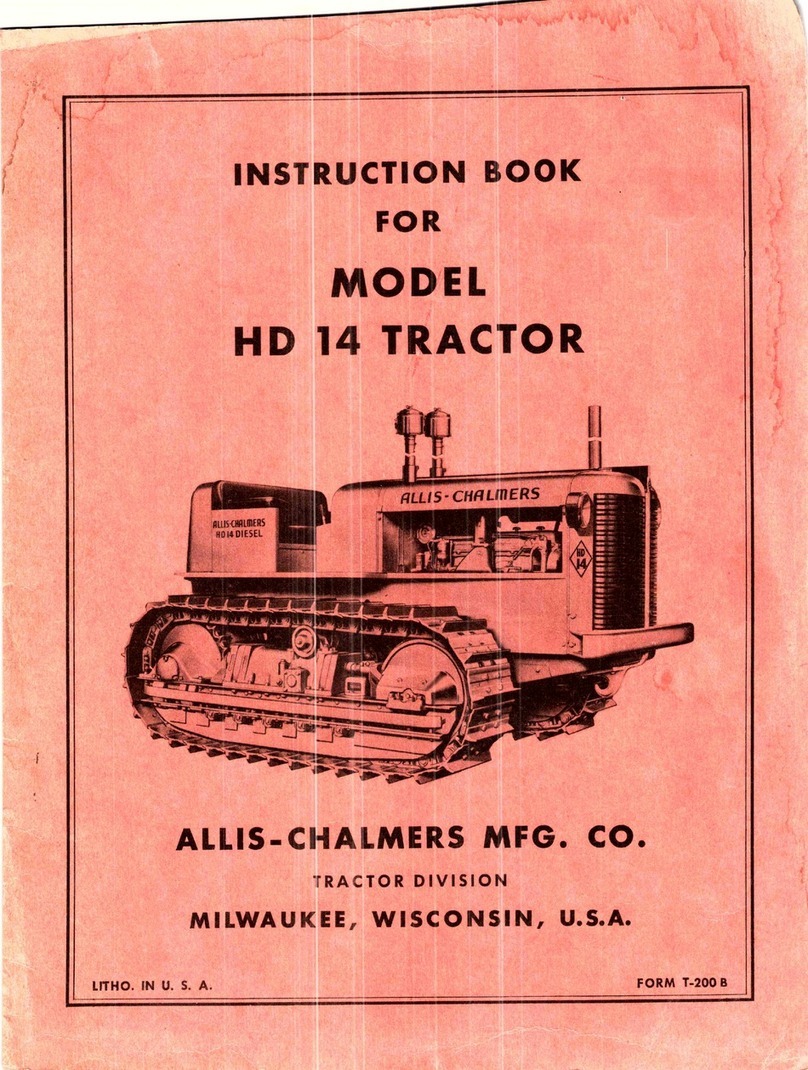
Allis-Chalmers
Allis-Chalmers HD-14 User manual
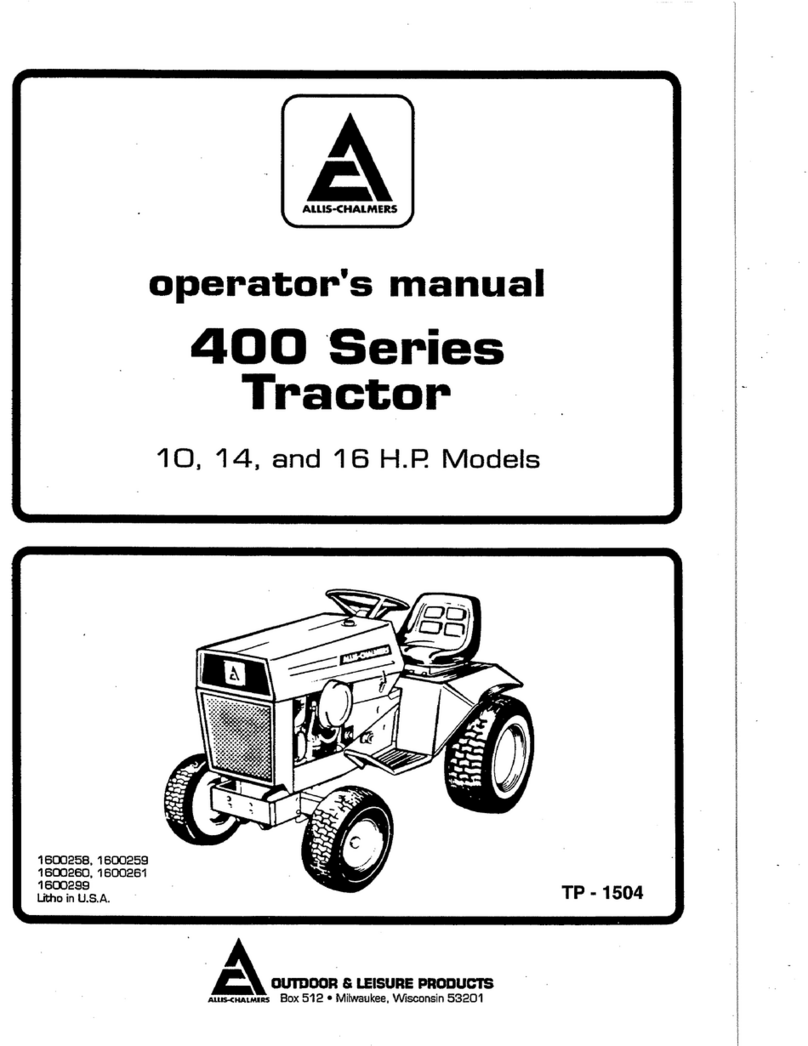
Allis-Chalmers
Allis-Chalmers regent hydro 14 User manual
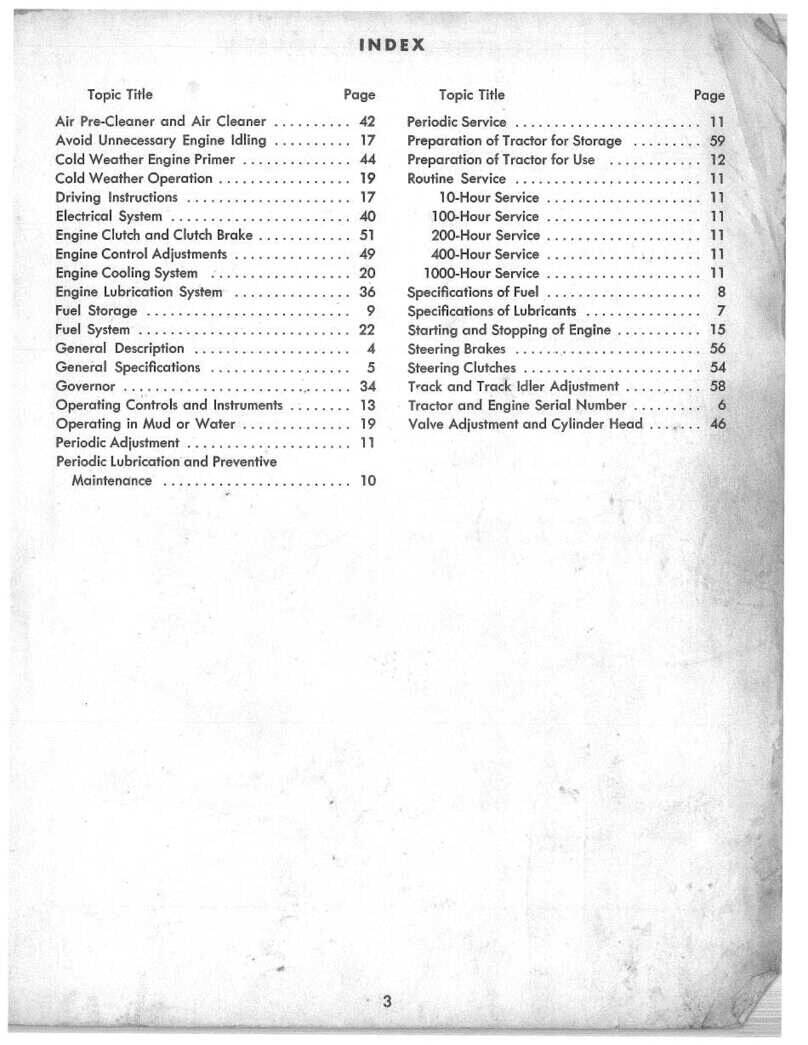
Allis-Chalmers
Allis-Chalmers HD 6B User manual
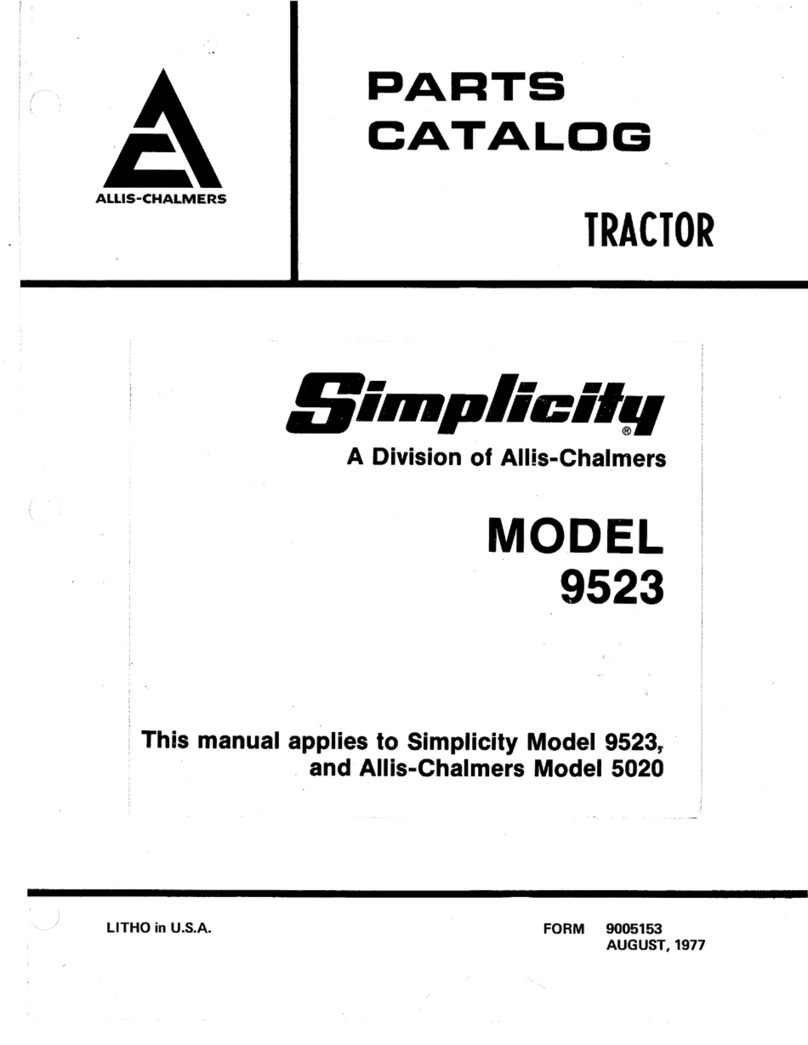
Allis-Chalmers
Allis-Chalmers Simplicity 9523 Instruction Manual
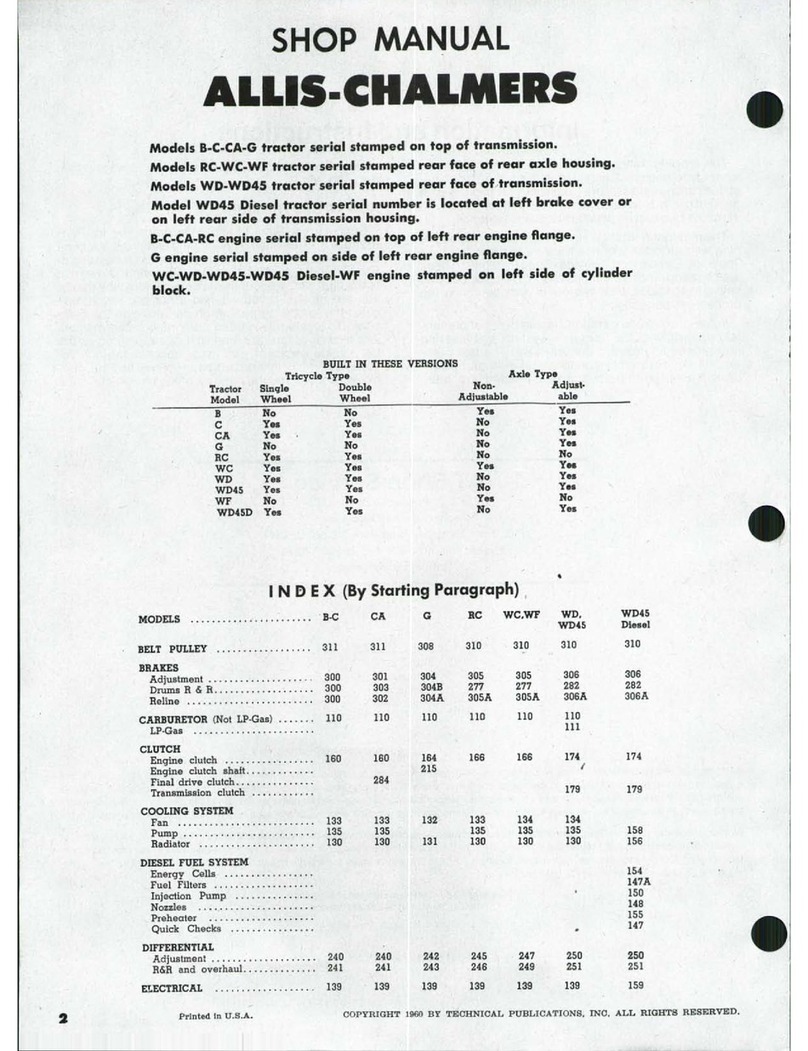
Allis-Chalmers
Allis-Chalmers B Install guide

Allis-Chalmers
Allis-Chalmers HD-5 User manual
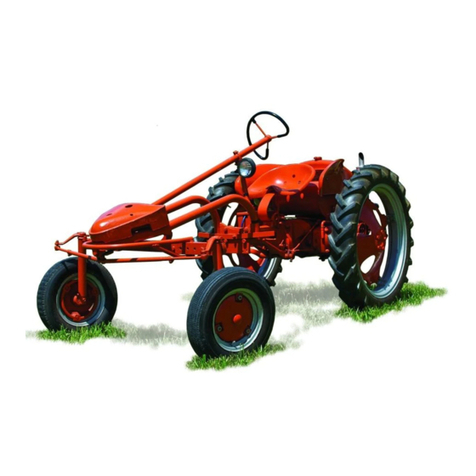
Allis-Chalmers
Allis-Chalmers G User manual
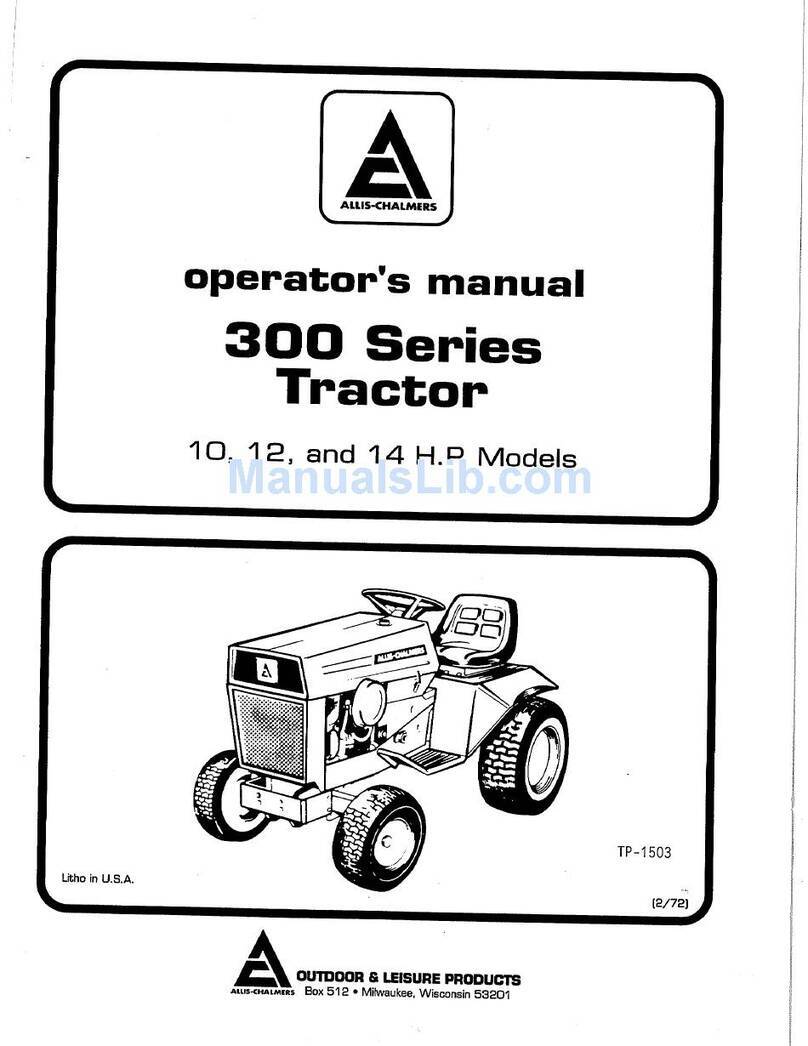
Allis-Chalmers
Allis-Chalmers 10 hp User manual
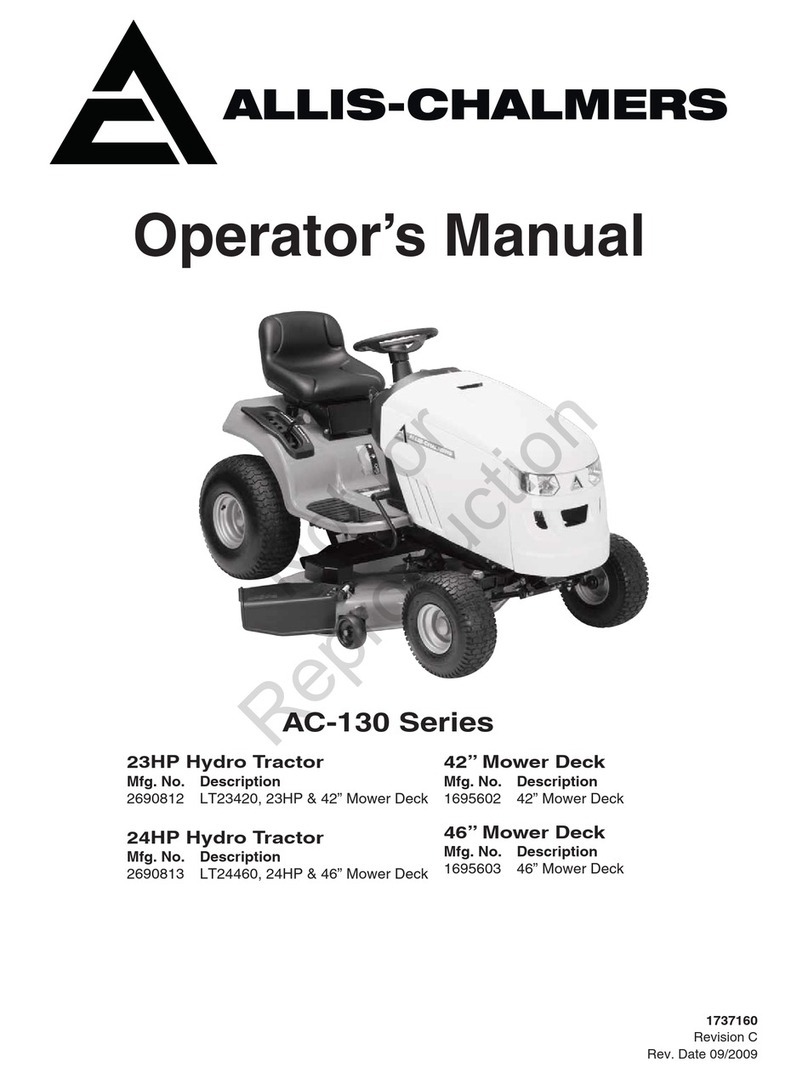
Allis-Chalmers
Allis-Chalmers ac130 series User manual
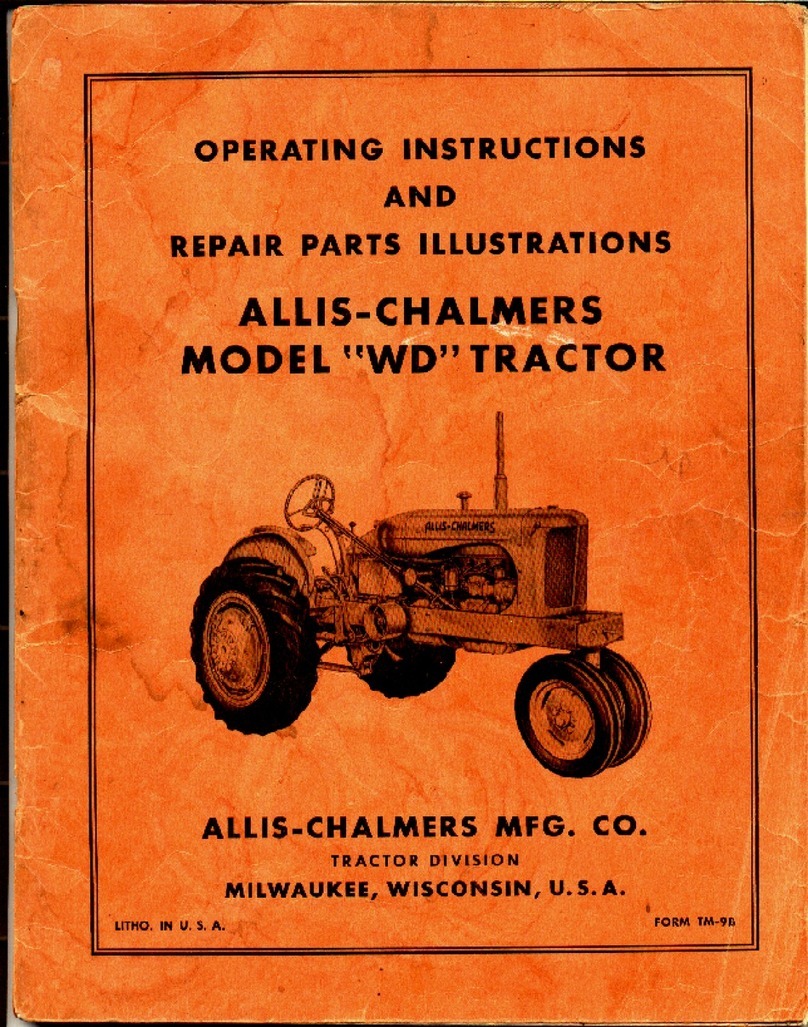
Allis-Chalmers
Allis-Chalmers WD Use and care manual
